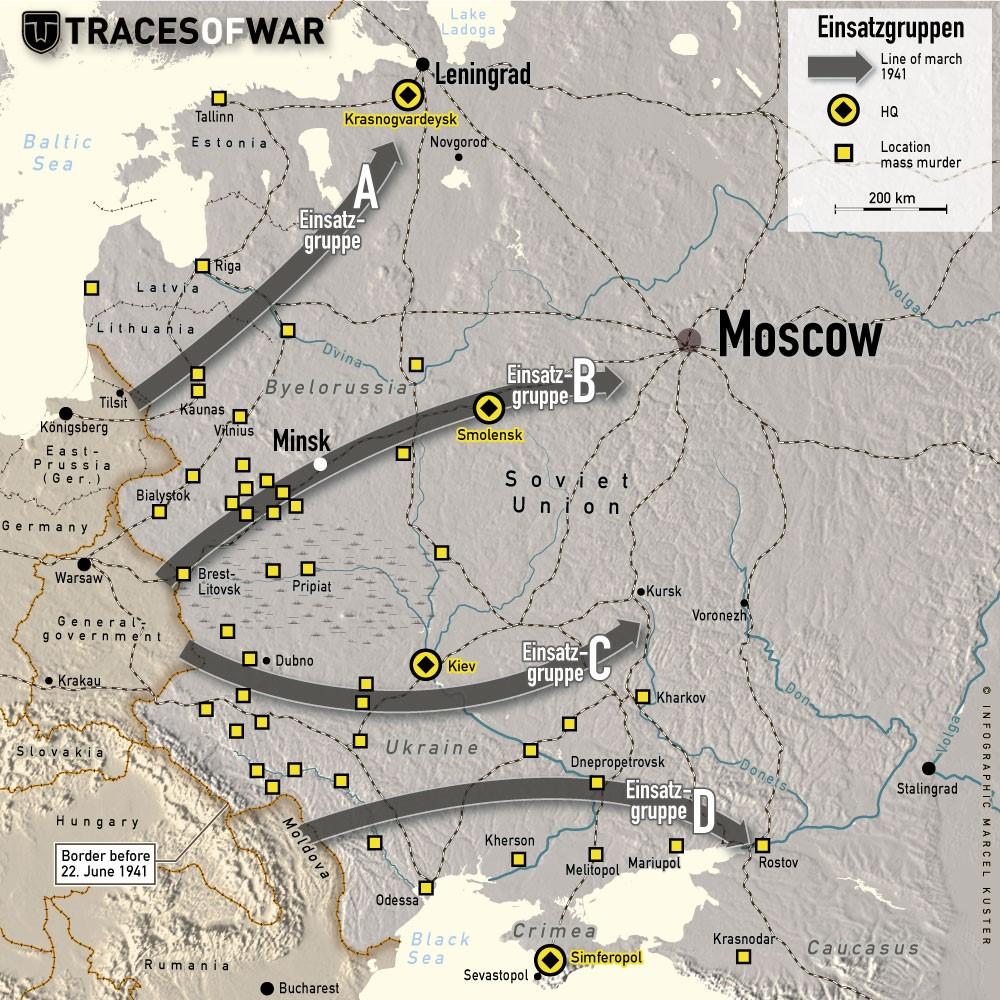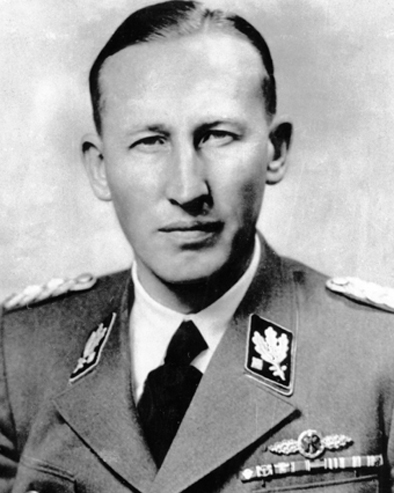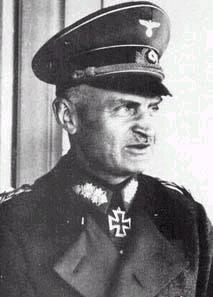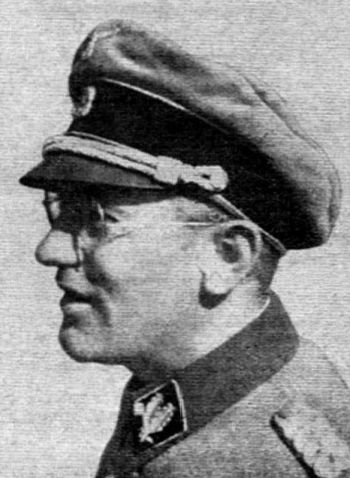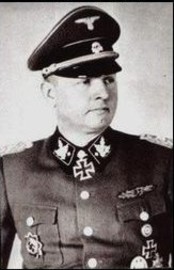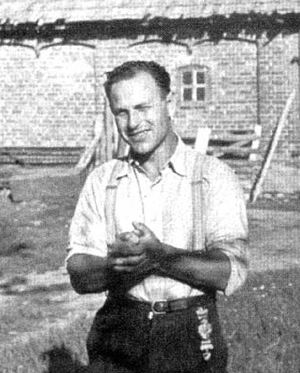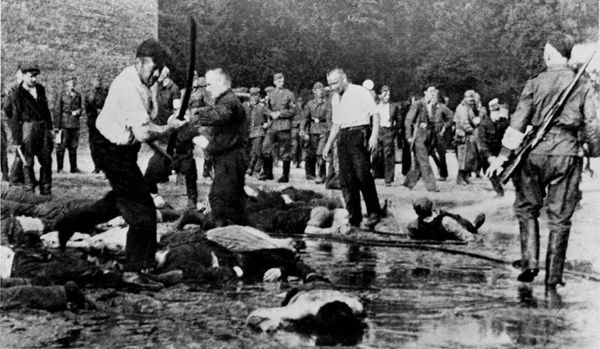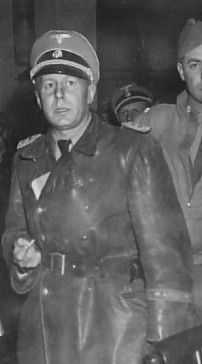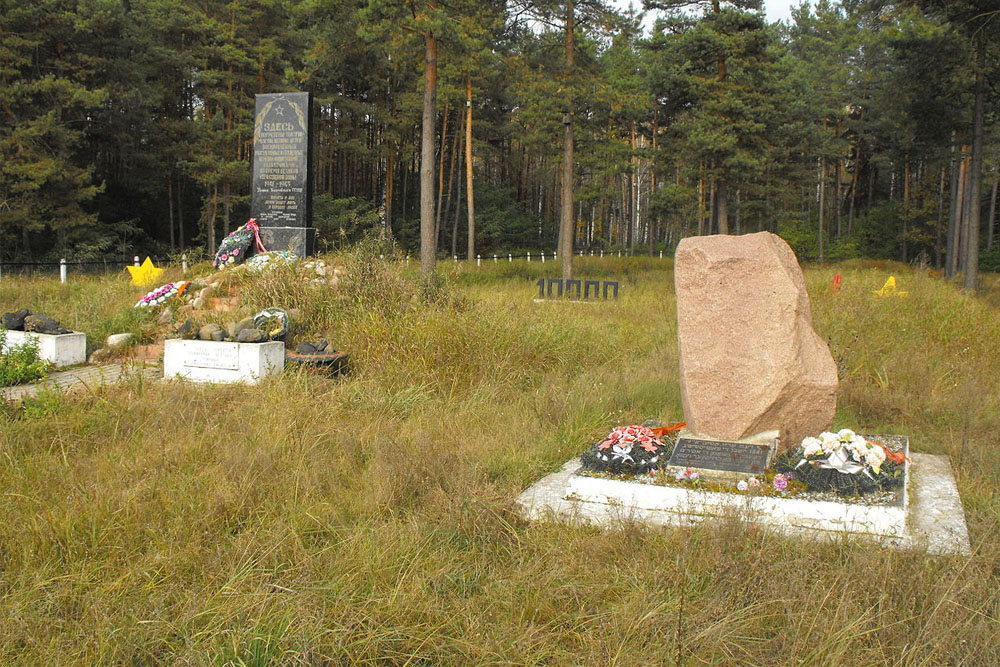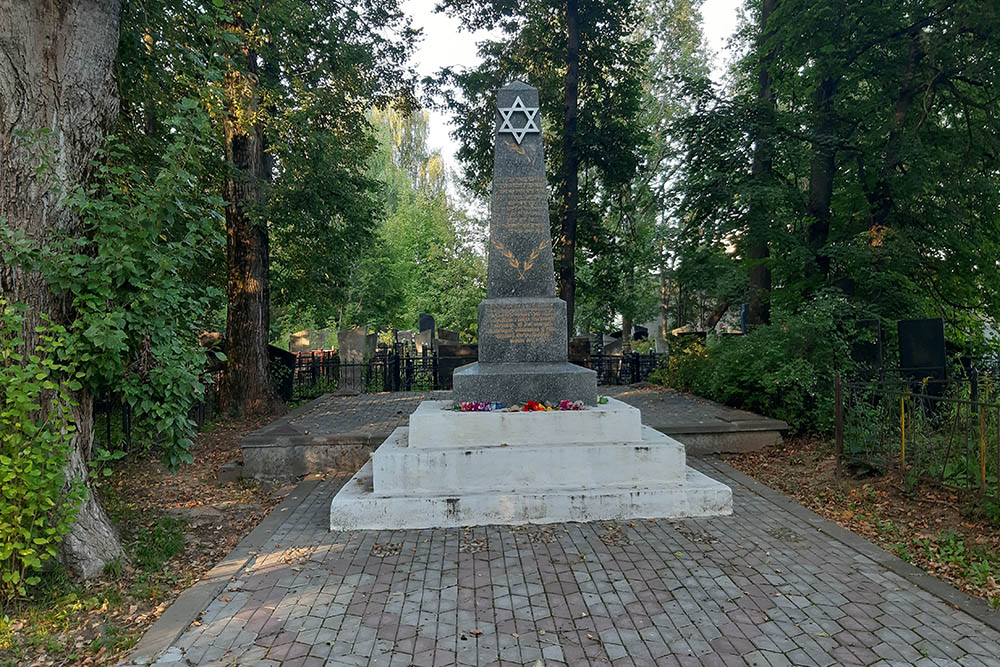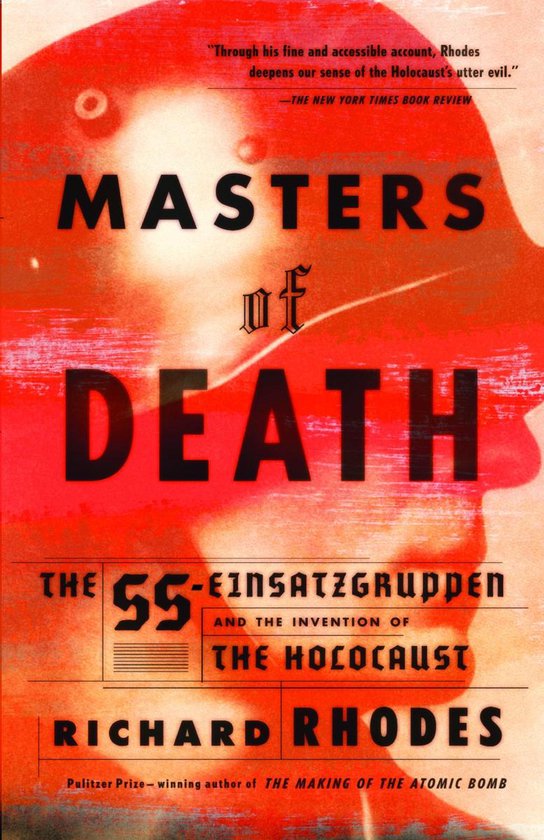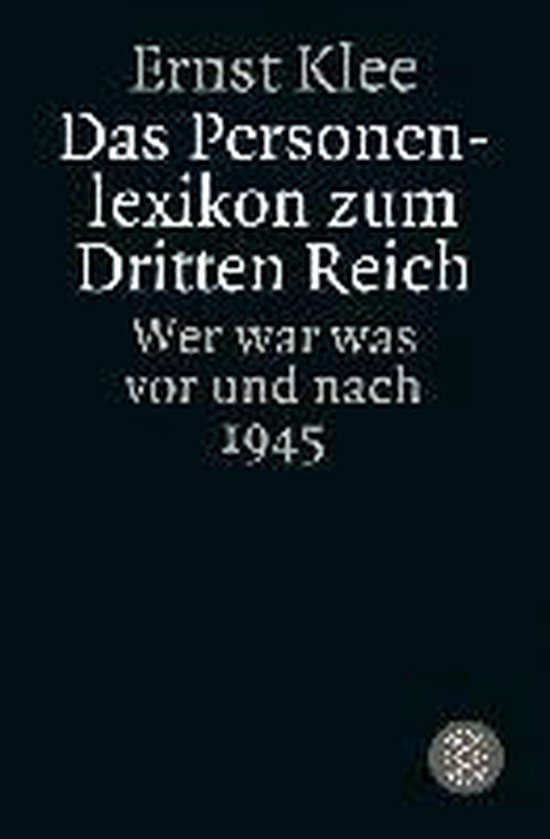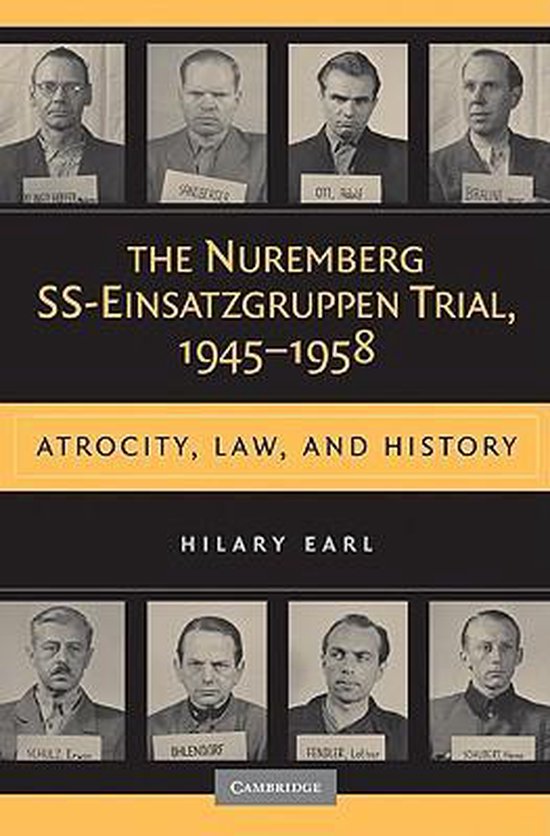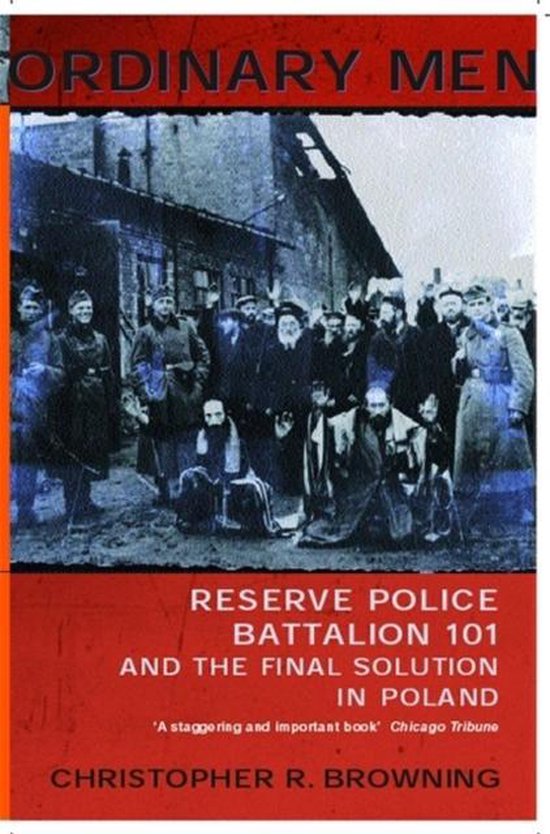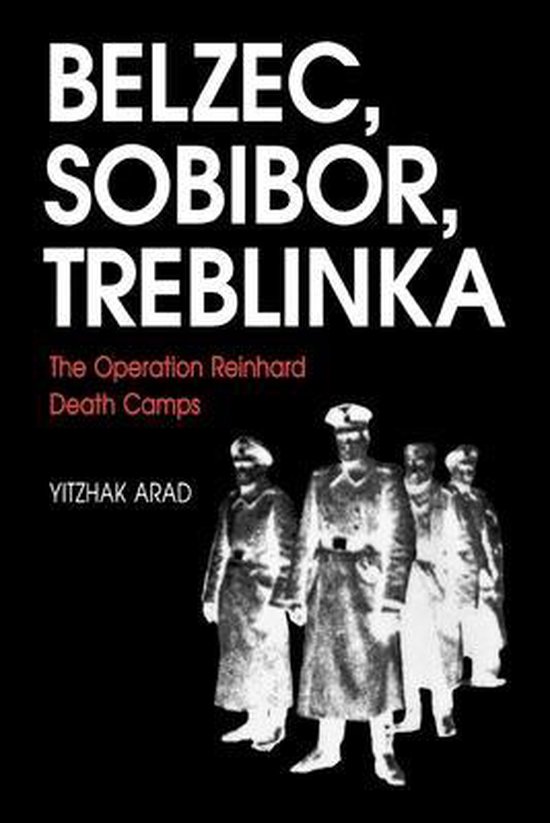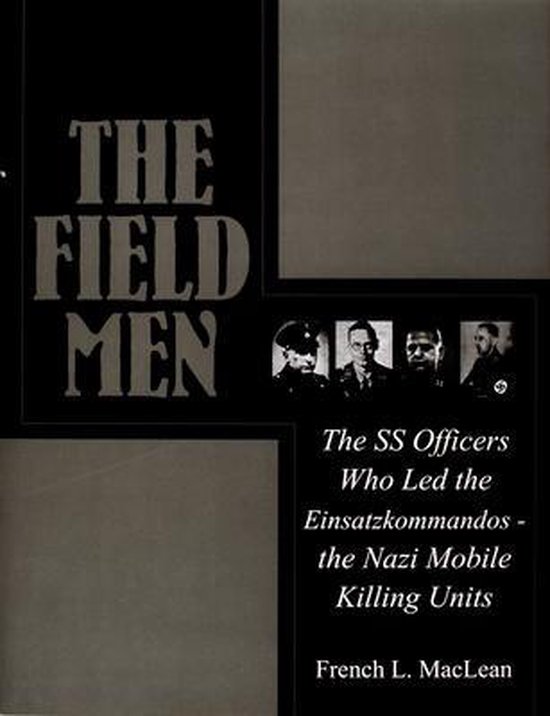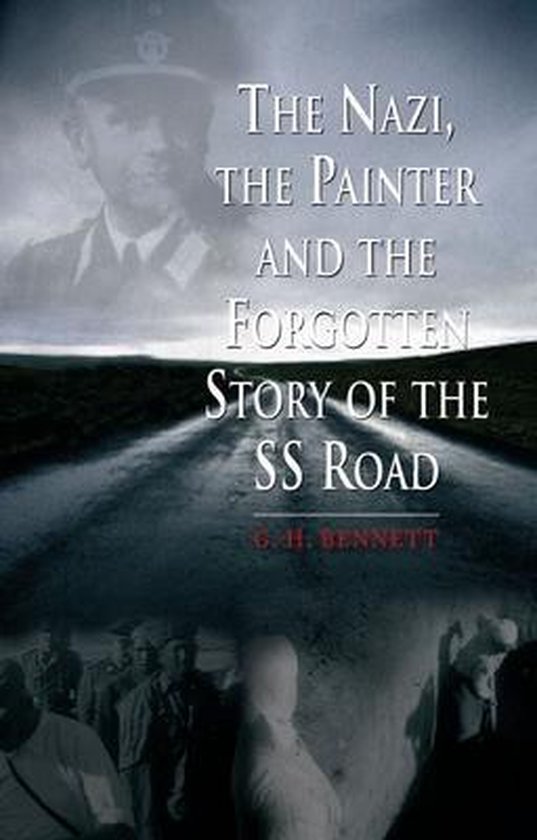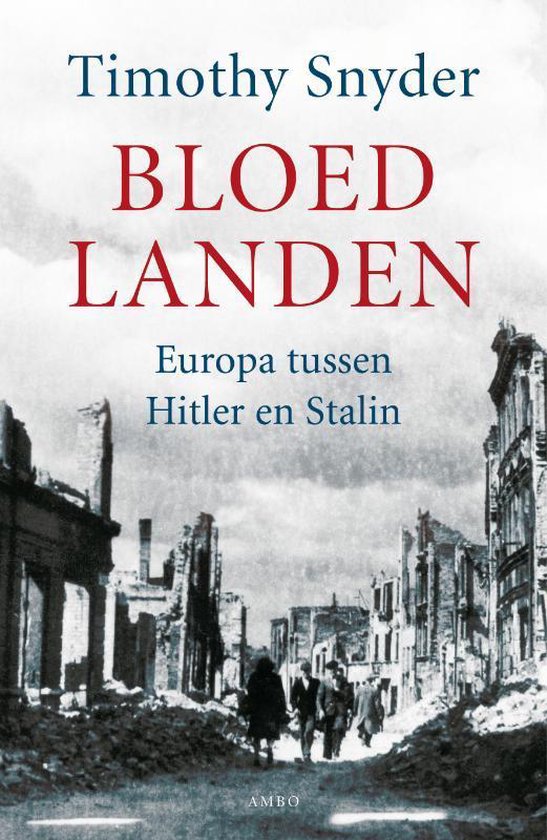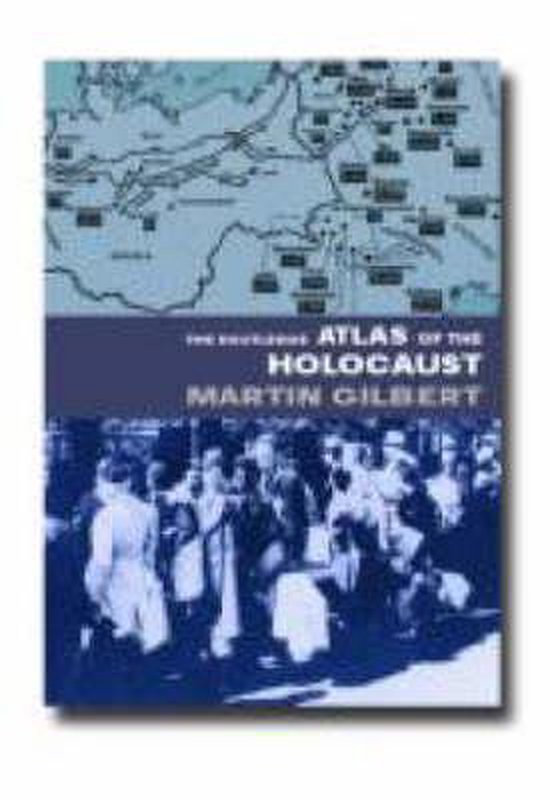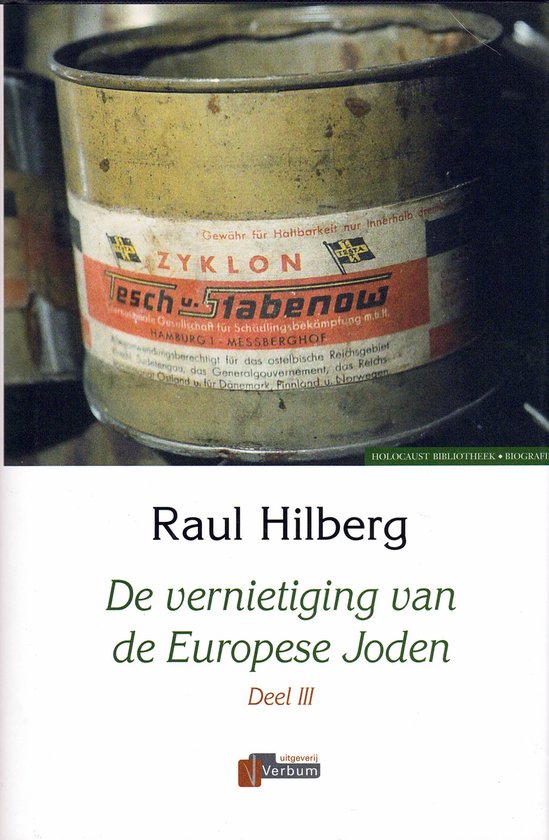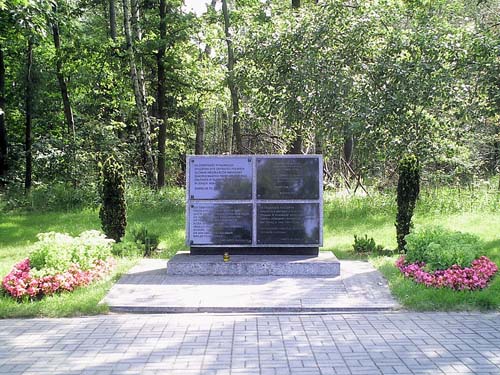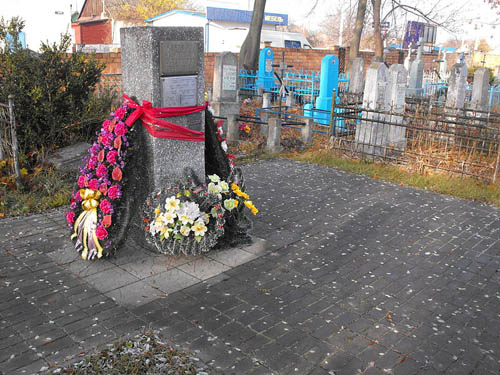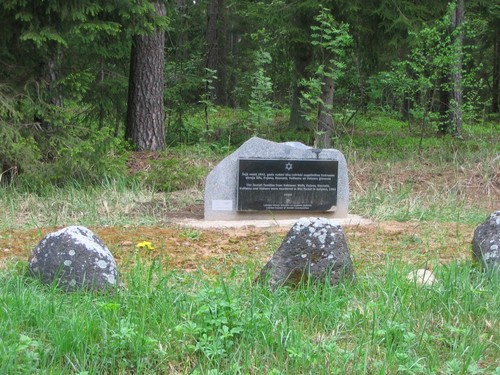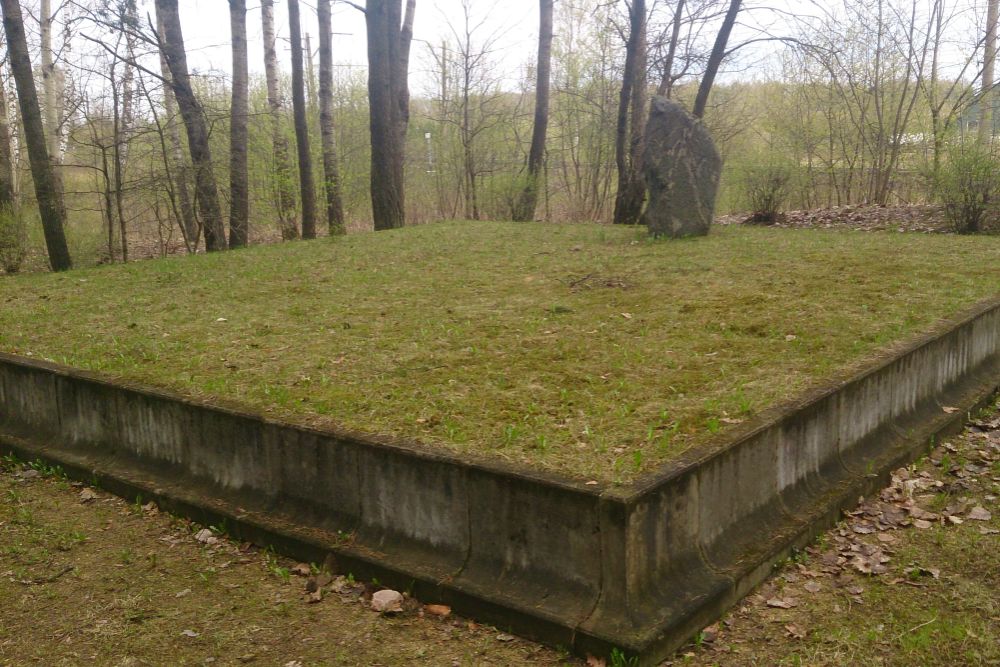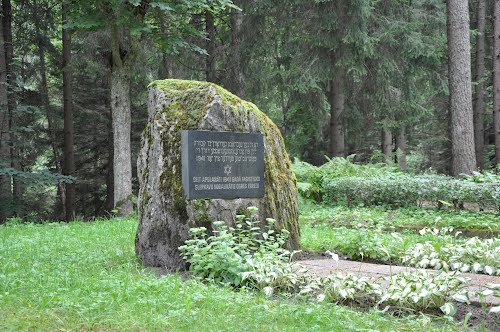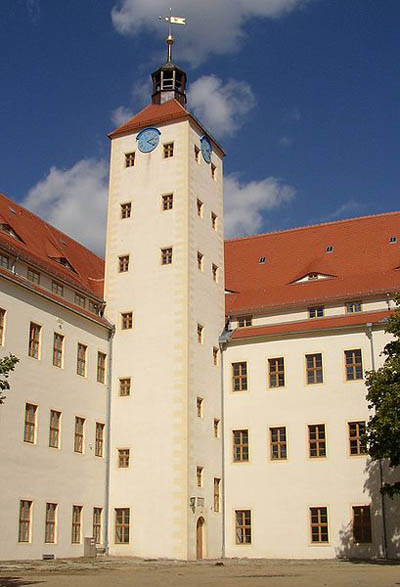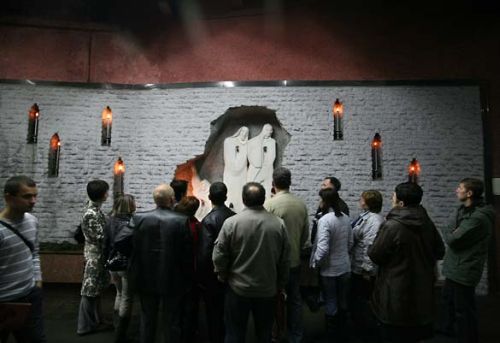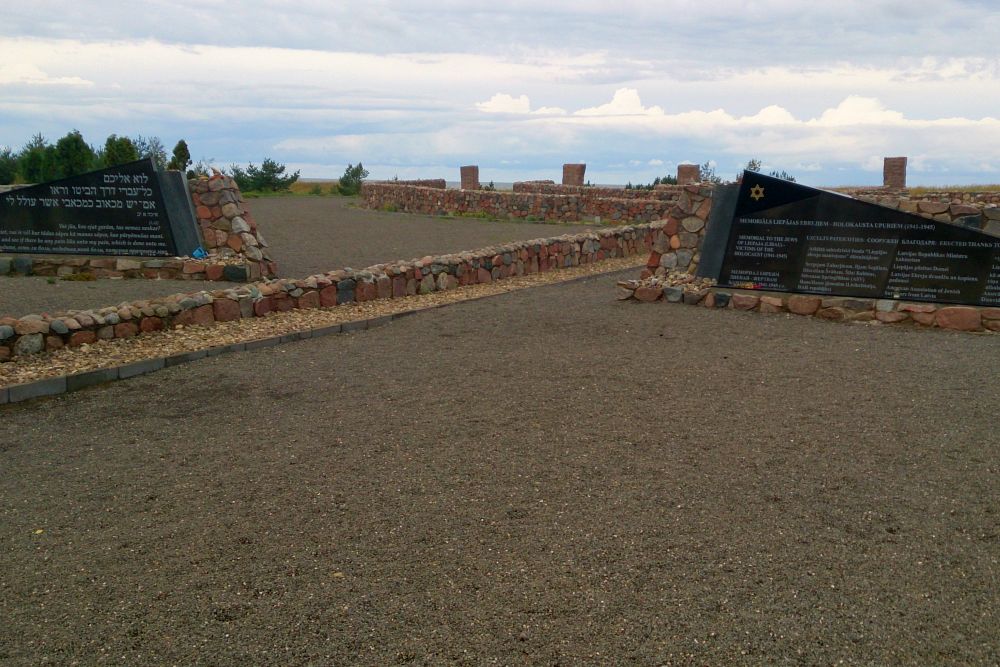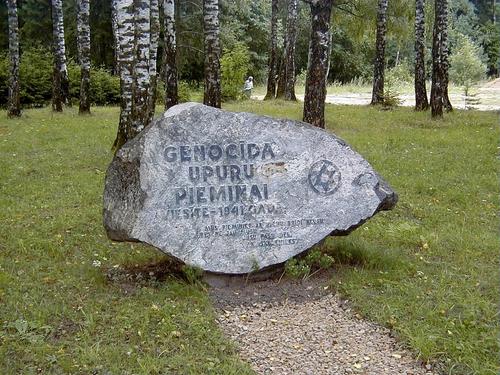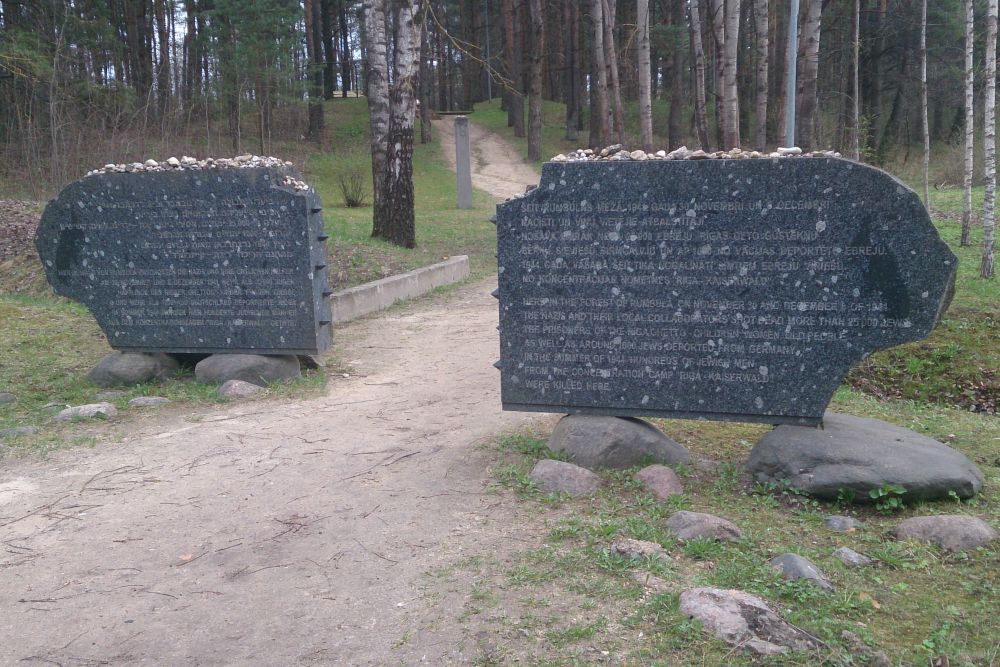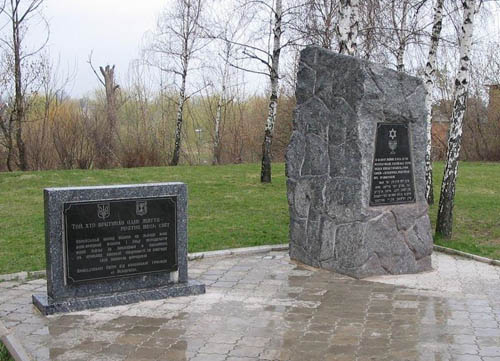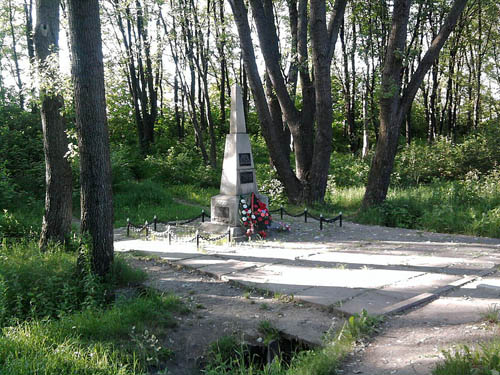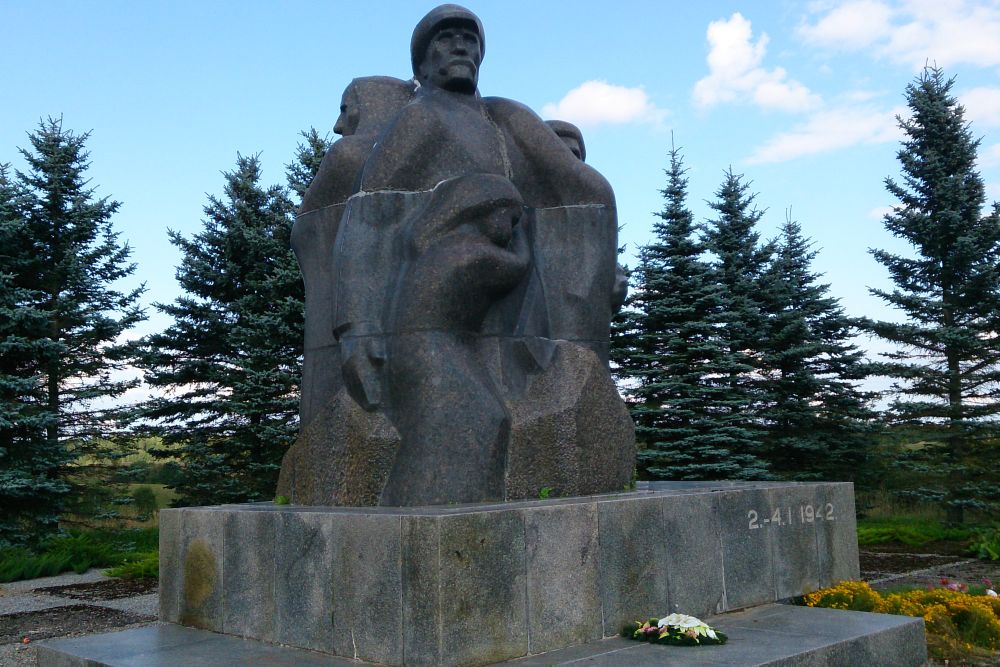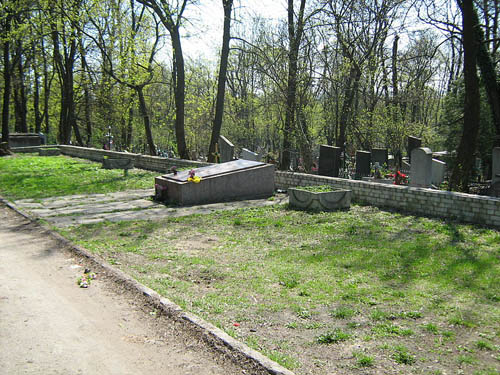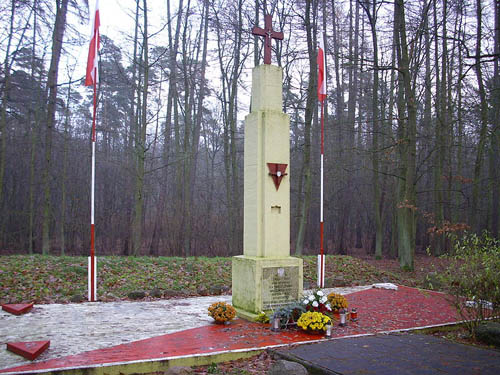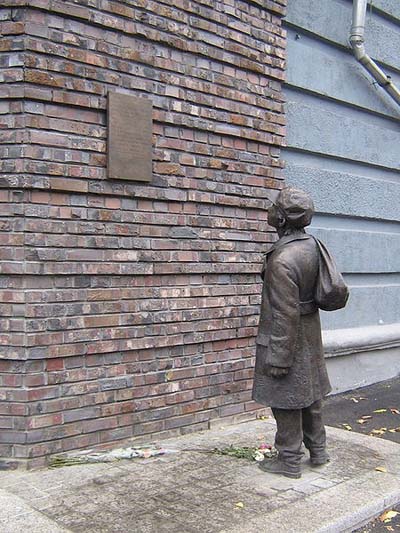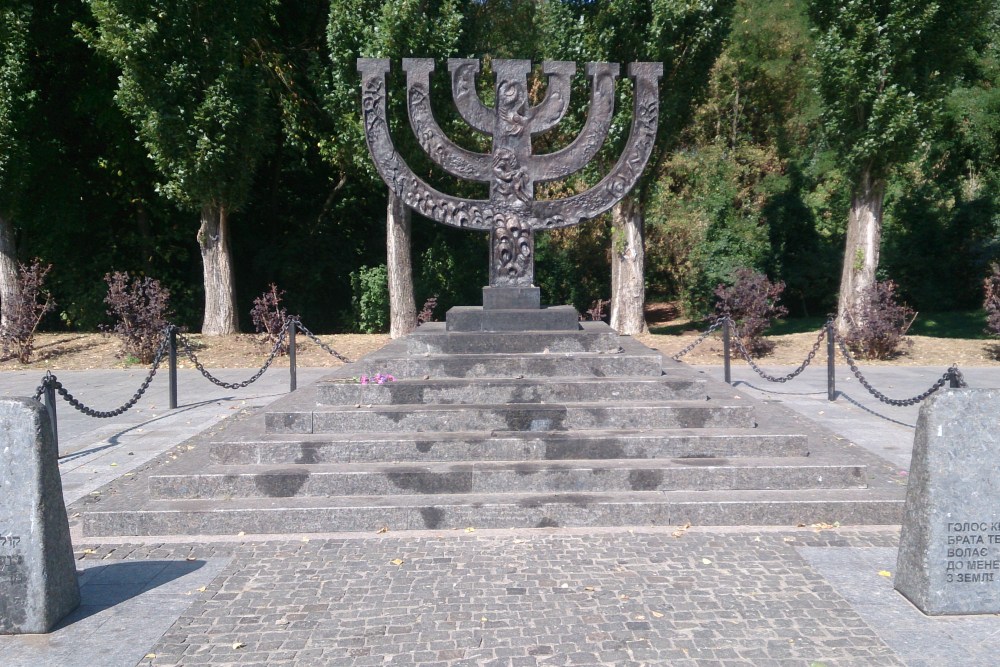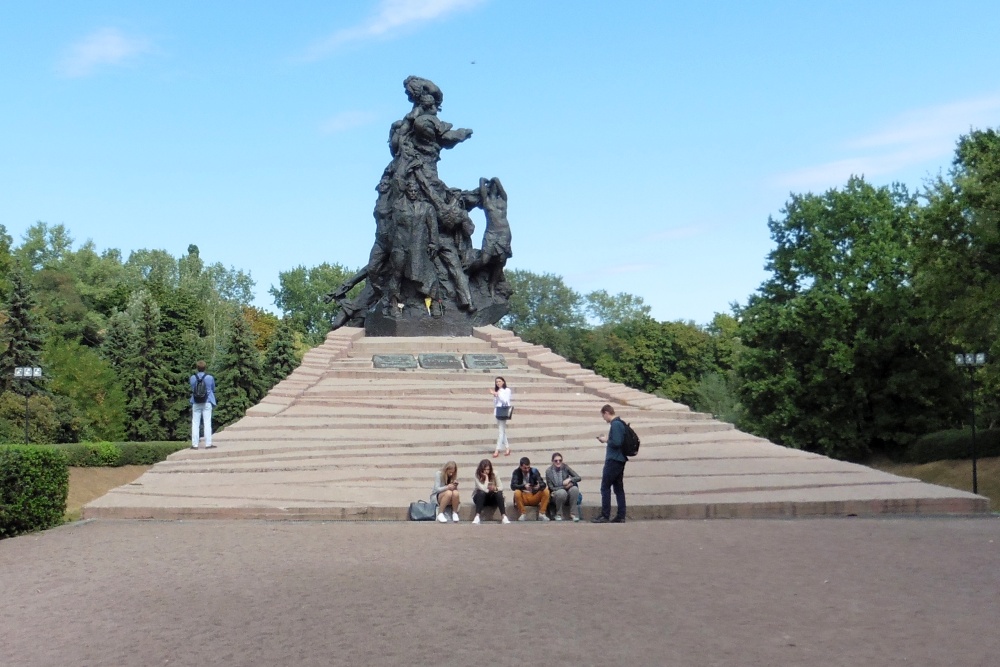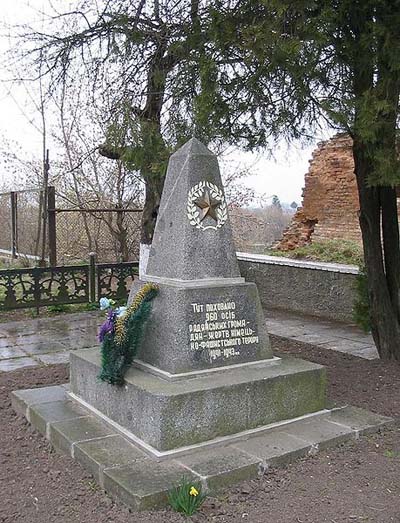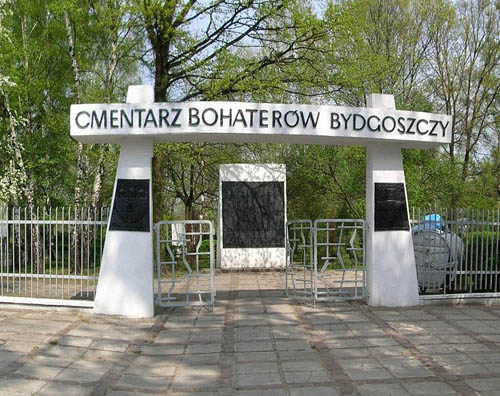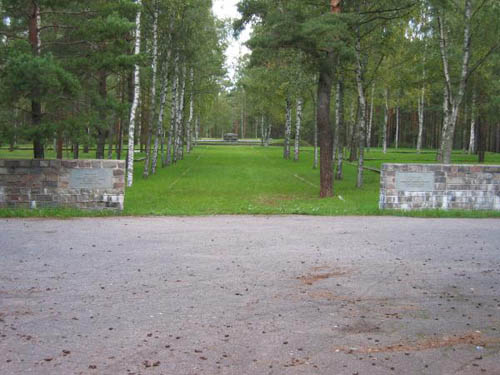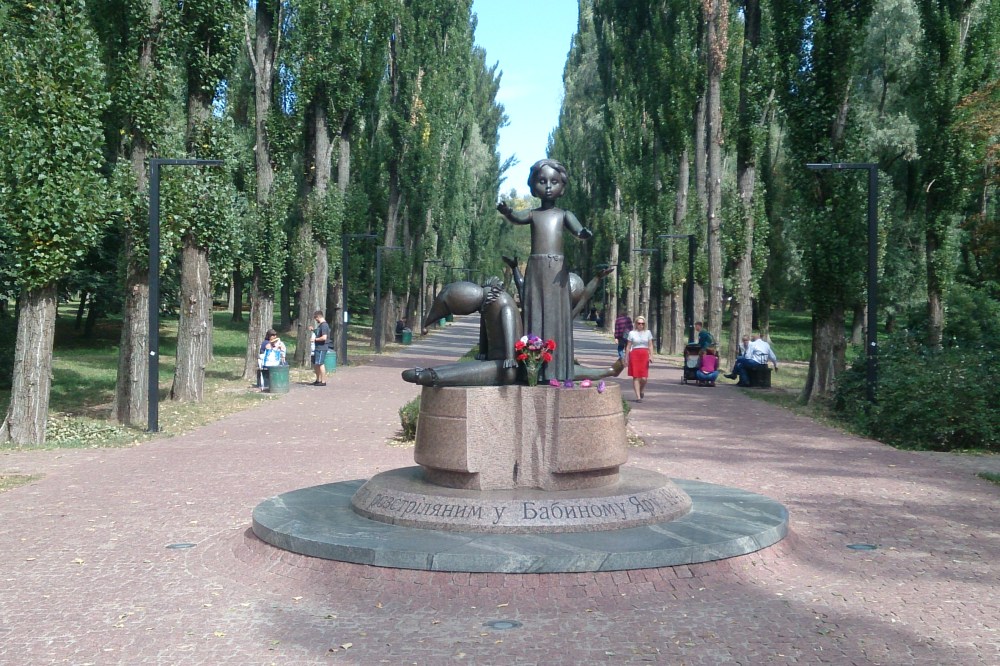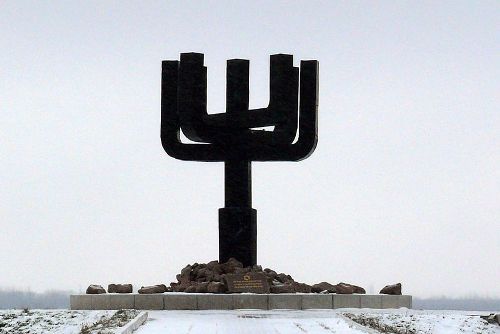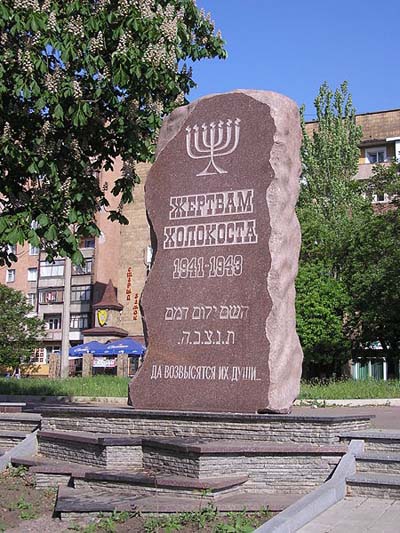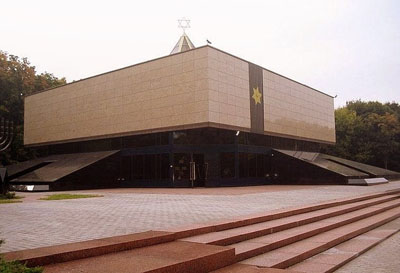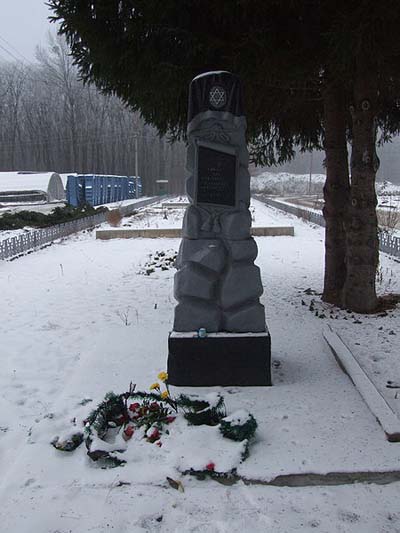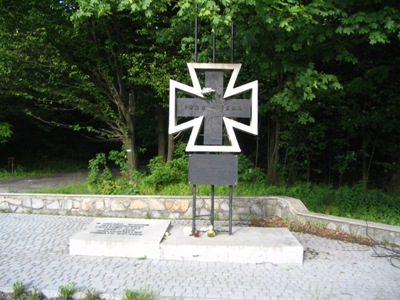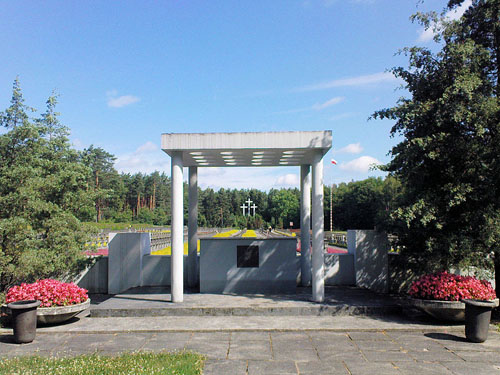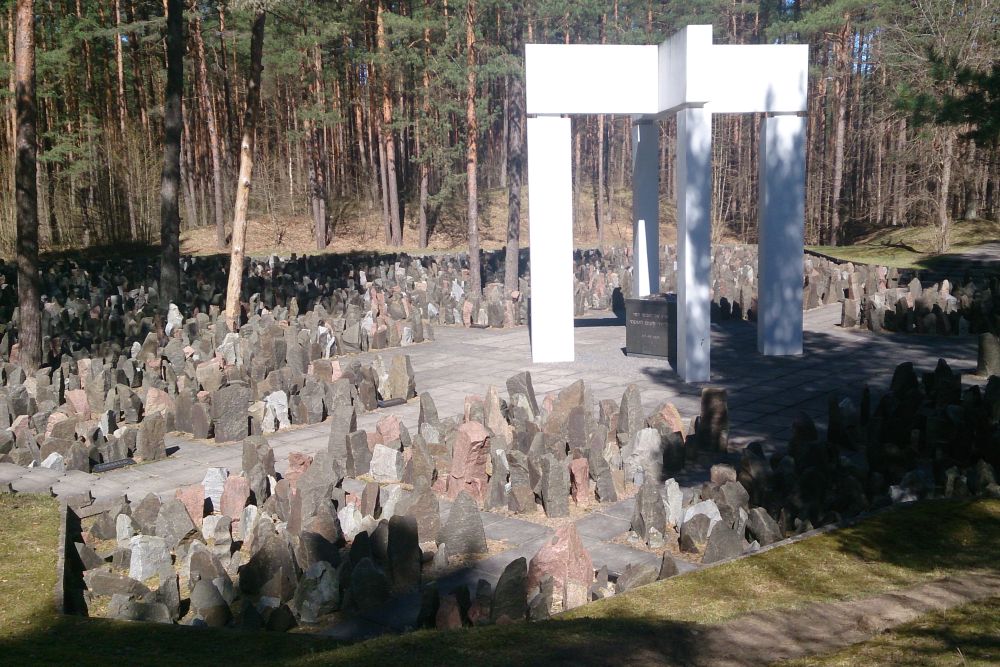Introduction
During the Second World War Nazi-Germany was responsible for the killing of approximately six million Jews. Although the gas chambers of Auschwitz-Birkenau, Sobibor and other extermination camps played a significant role in the extermination program, the mass murder had already started before these killing centers even existed. During Operation Barbarossa, the German invasion of the Soviet-Union in June 1941, the troops of the Wehrmacht were followed by four so-called Einsatzgruppen der Sicherheitspolizei und des Sicherheidsdienstes (Einsatzgruppen or Special Action Squads), special armed units of the SS which were officially charged with police and safety matters in the military occupation zones.
These fast moving teams carried out arrests and mass executions anywhere they appeared; apart from Jews, Communists, gypsies and psychiatric patients fell victim to them as well. During the Nazi occupation of the Soviet-Union, in addition to the victims of the mass extermination in the camps, more than 1 million Soviet Jews were killed, mainly by shooting. Many of these executions were carried out by the Einsatzgruppen, assisted by local collaborators.
Definitielijst
- Auschwitz-Birkenau
- The largest German concentration camp, located in Poland. Liberated on 26 January 1945. An estimated 1,1 million people, mainly Jews, perished here mainly in the gas chambers.
- Einsatzgruppen
- "Taskforces of Deployment Squads". Special units composed of various SS and police services under supervision of the Reichssicherheitshauptamt (RSHA). Einsatzgruppen were deployed during the invasion of Poland in 1939 and during operation Barbarossa in 1941. In 1939 these units were ordered to eliminate the Polish intelligentsia. In the Soviet Union they were deployed to execute various political and racial enemies of the Third Reich, like Jews, gypsies and communists. The "Holocaust by bullets" in the Soviet Union was the horrendous first act of the eventual "final solution".
- invasion
- Armed incursion.
- Jews
- Middle Eastern people with own religion that lived in Palestine. They distinguished themselves by their strong monotheism and the strict observance of the Law and tradition. During World War 2 the Jewish people were ruthlessly persecuted and annihilated by the German Nazis. . An estimated 6,000,000 Jews were exterminated.
- Nazi
- Abbreviation of a national socialist.
- Wehrmacht
- German armed military forces, divided in ground forces, air force and navy.
Images
Historical account
The four Einsatzgruppen which were active during the German campaign in the Soviet-Union were established as early as March 1938 prior to the non-violent invasion of Austria, the so-called Anschluss. At that time the first Einsatzgruppe, commanded by Franz Six, was established by Reinhard Heydrich (Bio Heydrich), the Chief of the Sicherheitsdienst (SD, Security Service) on special order of Hitler (Bio Hitler). The unit, consisting of men from the SD, followed the troops of the regular army as they crossed the Austrian border in order to annex the neighbouring country. It was their task to gather intelligence for the benefit of the future German administration. They accomplished this by occupying government buildings, interrogating government officials and safeguarding archives. For the annexation of the Sudetenland, the border area of Czechoslovakia with Germany and Austria in September 1938, two Einsatzgruppen were charged with the same task. Einsatzgruppe Wien was commanded by Heinz Jost and Einsatzgruppe Dresden by Franz Walter Stahlecker. At the invasion of the remainder of Czechia (Bohemia and Moravia) Einsatzgruppe I Prag and Einsatzgruppe II Brünn were deployed. Six, Jost and Stahlecker would also play a leading role in the Einsatzgruppen during the invasion of the Soviet-Union, but the mass murders they ordered at that time, were not carried out in Czechoslovakia and Austria.
With the German invasion of Poland in September 1939, the SS once more established Einsatzgruppen (officially designated Einsatzgruppen der Sicherheitspolizei), initially five but ultimately seven, each divided into Einsatzkommandos. The first six Einsatzgruppen were numbered from I to VI. The seventh was known as Einsatzgruppe zur besonderen Verwendung (z.b.V.) "Udo von Woyrsch" (Einsatzgruppe for special deployment), named after its commander SS-Obergruppenführer Udo von Woyrsch and was active especially in the industrial area of Upper-Silezia. Other commanders were for example SS-Standartenführer Bruno Streckenbach (I) and SS-Oberführer Erich Naumann (VI). Prior to the invasion of the Soviet-Union, the first named would become responsible for recruiting of men for the Einsatzgruppen as Chief of Amt I of the Reichssicherheitshauptamt; the latter would command Einsatzgruppe B from November 1941 to March 1943. The total strength of the Einsatzgruppen in Poland was approximately 2,700 men, consisting of members of the SS and the German police force. This time their job would not be limited to gathering intelligence and safeguarding information, but they were assigned all kinds of police and military tasks, including executions.
Each of the Einsatzgruppen I to V was assigned to the operational areas of the five army groups that invaded Poland and operated formally under orders of the Wehrmacht, but received their orders direct from Reichsführer-SS Heinrich Himmler (Bio Himmler). Einsatzgruppe VI operated exclusively in the Posen region (Poznan). In their respective theatres of operation, the Einsatzgruppen were to arrest political opponents, confiscate weapons and act against hostile elements, such as partisans and spies in the area behind the front. In addition they had to participate in the execution of Operation Tannenberg, the annihilation of the Polish intellectual elite. Prior to the invasion the SS had gathered the names of 60,000 Polish academics and intellectuals. These people, including nationalist politicians and Roman Catholic leaders, had to be tracked down by the Einsatzgruppen and were subsequently executed. The reason behind this was that Adolf Hitler wanted to subjugate the Polish people and deploy them as poorly educated slaves for the German Reich. The Polish nation had to be liquidated and all rights on autonomy and higher education were denied them. In order to prevent resistance and the risk of a new class of leaders arising, the Polish intelligentsia had to be eliminated once and for all.
Between 1 September and 25 October, 1939, German troops destroyed approximately 531 villages and executed 16,376 persons in Poland. Protests by Generaloberst Johannes Blaskowitz (Bio Blaskowitz), the German Wehrmacht commander in Poland, against the mass murder of civilians were brushed aside by Adolf Hitler downright. Several other Wehrmacht commanders were less scrupulous and had their men participate in the murders. In total, including the period between 25 October, 1939 until the spring of 1940, 60,000 to 80,000 executions are attributed to the Einsatzgruppen in Poland. Although no formal orders existed to this effect, many violent and random excesses against Jewish civilians took place, often carried out by members of the Einsatzgruppen. Synagogues were set ablaze and Jews were executed, for example in Bêdzin in the south of Poland where over 500 Jews were killed within two days. As a consequence of the anti-Semitic violence, hundreds of thousands of Jews fled to eastern Poland, occupied by the Soviet-Union after it had invaded the country on 17 September, 1939. Following the German invasion of the Soviet-Union, many of these Jewish refugees would still fall victim to the Nazi terror.
Definitielijst
- Einsatzgruppen
- "Taskforces of Deployment Squads". Special units composed of various SS and police services under supervision of the Reichssicherheitshauptamt (RSHA). Einsatzgruppen were deployed during the invasion of Poland in 1939 and during operation Barbarossa in 1941. In 1939 these units were ordered to eliminate the Polish intelligentsia. In the Soviet Union they were deployed to execute various political and racial enemies of the Third Reich, like Jews, gypsies and communists. The "Holocaust by bullets" in the Soviet Union was the horrendous first act of the eventual "final solution".
- invasion
- Armed incursion.
- Jews
- Middle Eastern people with own religion that lived in Palestine. They distinguished themselves by their strong monotheism and the strict observance of the Law and tradition. During World War 2 the Jewish people were ruthlessly persecuted and annihilated by the German Nazis. . An estimated 6,000,000 Jews were exterminated.
- Nazi
- Abbreviation of a national socialist.
- resistance
- Resistance against the enemy. Often also with armed resources.
- Wehrmacht
- German armed military forces, divided in ground forces, air force and navy.
Images
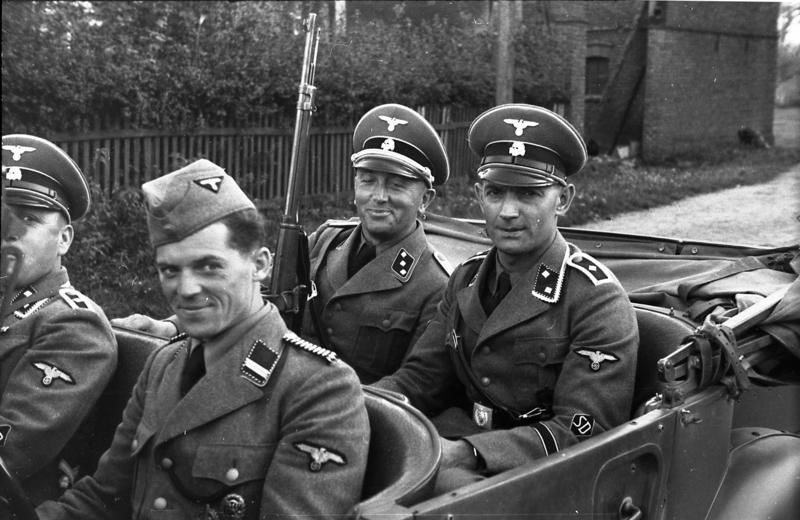 SD officers (likely members of an Einsatzgruppe) during the invasion of Poland in September 1939. Source: Bundesarchiv / Wikimedia Common.
SD officers (likely members of an Einsatzgruppe) during the invasion of Poland in September 1939. Source: Bundesarchiv / Wikimedia Common.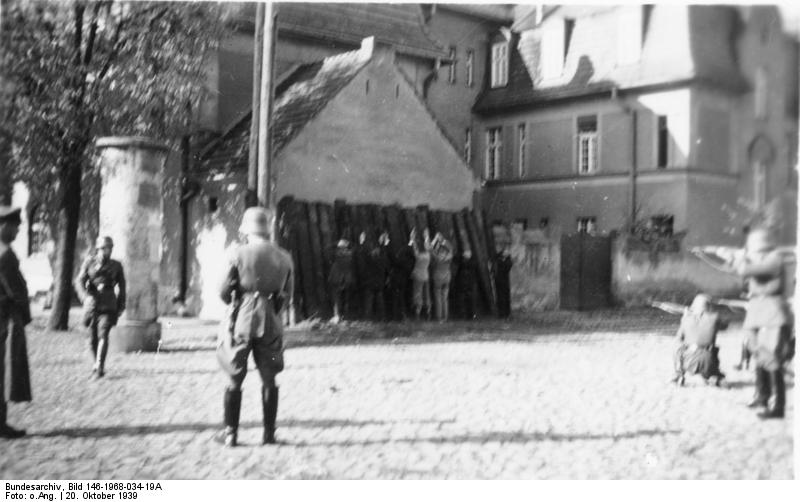 Execution of Polish hostages by members of an Einsatzgruppe on 20 October 1939 in Kornik in West-Poland. Source: Bundesarchiv.
Execution of Polish hostages by members of an Einsatzgruppe on 20 October 1939 in Kornik in West-Poland. Source: Bundesarchiv.Preparations for a war of destruction
The Einsatzgruppen and Einsatzkommandos were also being deployed for the invasion of Western Europe, including the Netherlands and Belgium. Just like in Austria and Czechoslovakia, their advance was not accompanied by bloodshed and their job existed mainly of gathering intelligence and preparatory work for the occupation. If Germany had invaded Great Britain, five Einsatzgruppen would have been deployed with orders to arrest 2,820 prominent British citizens, among other things. After the defeat in the Battle of Britain in October 1940, the invasion of the United Kingdom however was postponed indefinitely. Adolf Hitler decided to settle accounts with the Soviet-Union first. Although he had signed a non-aggression pact with this country in August 1939, it was in fact Nazi-Germany’s natural enemy. Hitler and his followers greatly despised Communism and in "Mein Kampf" the German dictator had already hinted at a conquest of Soviet territory in order to create Lebensraum (space to live) for the German population.
The guideline for the German colonization of the East was the so-called Generalplan Ost, a series of plans which had been developed between January 1940 and May 1942 by order of Reichsfüher-SS Heinrich Himmler. The basic principle of the plans was always the same: millions of East-Europeans labelled to be racially undesirable, including Jews and Slavs, were to be deported to Siberia or be killed right away in order to create space for German colonists. Massive starvation was considered as a means to achieve this goal. Part of the local population was allowed to remain in order to serve as slave laborers for the German rulers and another part was supposed to be racially fit for Arisierung (germanization). Within the Wehrmacht, preparations were also made with the same cruelty for the invasion, Operation Barbarossa. The battle was considered a war of destruction, aimed at the total annihilation of Bolshevism. It was decided that not one German soldier had to fear being prosecuted for war crimes: "In the battle against Bolshevism, the basics of humanity and of human rights need not to be taken into account as far as the enemy is concerned", as had been laid down in the so-calle Kommissarbefehl (Commissioner order), issued by the Oberkommando der Wehrmacht (O.K.W., Supreme Command of the Armed Forces), which was a license to execute captured political Kommissars of the Red Army. This order was titled in full: "Richtlinien für die Behandlung der politischer Kommissare " (Regulations for the treatment of political Kommissars).
In Operation Barbarossa an active role was reserved for the Einsatzgruppen. As the Wehrmacht advanced, they would eliminate hostile elements in the area behind the frontline. Close communication had been established beforehand between the command of the Wehrmacht and the Reichssicherheitshauptamt (RSHA), the head office of the SS, consisting of the SD and the Sicherheitspolizei, established on 27 September 1939 and which virtually directed the entire German security apparatus. On 13 March, 1941, Generalfeldmarshall Wilhelm Keitel, Chief of the O.K.W., signed directives entitled: "Richtlinien auf Sondergebieten zur Weisung nr. 21 – Fall Barbarossa" (Guidelines for special areas in Directice nr. 21, Operation Barbarossa), laying down the competencies of the Army, the SS and the police forces on the Eastern front. The Einsatzgruppen and their tasks were not mentioned explicitly but it was clear that in the theatres of operation, Reichsfüher-SS Heinrich Himmler had been authorized by the Führer, Adolf Hitler, to "carry out special tasks in order to the establish a political administration, tasks that follow from the battle between two conflicting political systems which is to be concluded once and for all".
Himmler was allowed to act independently and on his own responsibility, as long as military operations were not impeded in the process.
Contrary to the Polish campaign, the Einsatzgruppen were no longer formally subordinate to the Wehrmacht. It was decided that at the start of the German invasion, the German – Soviet border was to be closed to all non-military traffic, except to police forces operating on orders from Himmler. Supply and lodging of Himmlers’ forces were still the responsibility of the Oberkommando des Heeres (O.K.H., Supreme Command of the Army), in the person of Generalquartiermeister Eduard Wagner.
Himmler left further organization to Reinhard Heydrich, the Chief of the RSHA. Heydrich consulted Generalquartiermeister Wagner about the conditions the Einsatzgruppen would require for operations in the Soviet-Union. In an agreement between the army and the RSHA of 26 March, 1941, the task of the Einsatzgruppen (still called Sonderkommandos here) were specified in more detail yet: "Within the framework of their orders and on their own responsibility the Sonderkommandos are allowed to take executive measures against the civilian population." This agreement was an unrestricted licence to execute civilians. It was agreed upon that the units would be subordinate to the territorial military commanders, but that executive control would lay with the RSHA. The units were granted full freedom of movement between the front areas and the army had to provide them with lodging, fuel, food rations, as well as radio communications when needed. After final discussions a definitive agreement was signed in May between Heydrich and Wagner. On one subject, the conditions differed from earlier agreements: the Einsatzgruppen were not only authorized to operate behind the frontlines, but also right at the front itself. Consequently, the targeted victims of the Einsatzgruppen did not have any chance to escape in time.
Definitielijst
- Communism
- Political ideology originating from the work of Karl Marx “Das Kapital” written in 1848 as a reaction to the so-called class struggle between the proletariat (labourers) and the bourgeoisie. According to Marx the proletariat would take over power from the well-to-do classes though a revolution. The communist movement aspires an ideal situation where the means of production and the means of consumption are common property of all citizens. This should end poverty and inequality (communis = common).
- Einsatzgruppen
- "Taskforces of Deployment Squads". Special units composed of various SS and police services under supervision of the Reichssicherheitshauptamt (RSHA). Einsatzgruppen were deployed during the invasion of Poland in 1939 and during operation Barbarossa in 1941. In 1939 these units were ordered to eliminate the Polish intelligentsia. In the Soviet Union they were deployed to execute various political and racial enemies of the Third Reich, like Jews, gypsies and communists. The "Holocaust by bullets" in the Soviet Union was the horrendous first act of the eventual "final solution".
- Führer
- German word for leader. During his reign of power Adolf Hitler was Führer of Nazi Germany.
- invasion
- Armed incursion.
- Jews
- Middle Eastern people with own religion that lived in Palestine. They distinguished themselves by their strong monotheism and the strict observance of the Law and tradition. During World War 2 the Jewish people were ruthlessly persecuted and annihilated by the German Nazis. . An estimated 6,000,000 Jews were exterminated.
- Lebensraum
- “Living space”. Nazi term indicating the need for the overpopulated German lands to expand.
- Mein Kampf
- “My Struggle”. Book written by Adolf Hitler, outlining the principles of National Socialism.
- Nazi
- Abbreviation of a national socialist.
- non-aggression pact
- Agreement wherein parties pledge not to attack each other.
- Red Army
- Army of the Soviet Union.
- RSHA
- Reichssicherheitshauptamt. The central information and security service of the Third Reich.
- war crimes
- Crimes committed in wartime. Often concerning crimes committed by soldiers against civilians.
- Wehrmacht
- German armed military forces, divided in ground forces, air force and navy.
Images
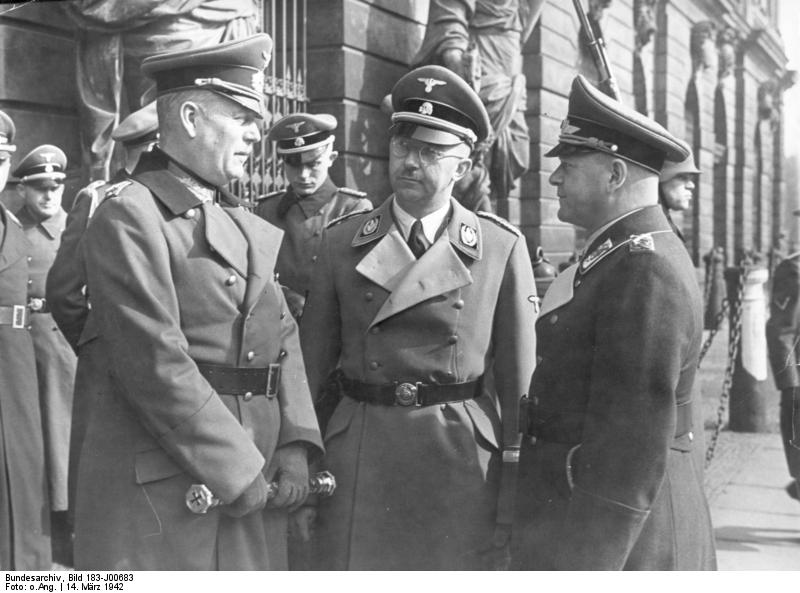 Wilhelm Keitel (left), Heinrich Himmler (center) and Erhard Milch in Berlin, 14 March 1943. Source: Bundesarchiv.
Wilhelm Keitel (left), Heinrich Himmler (center) and Erhard Milch in Berlin, 14 March 1943. Source: Bundesarchiv.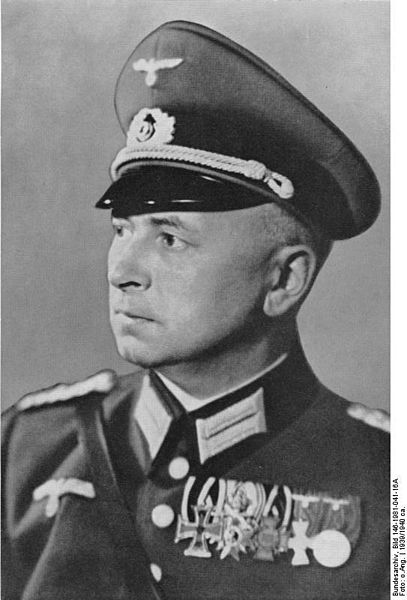 Generalquartiermeister Eduard Meister Source: Bundesarchiv.
Generalquartiermeister Eduard Meister Source: Bundesarchiv.Organization and Personnel
Prior to the German attack on the Soviet-Union four Einsatzgruppen were established which would operate during the invasion, each in a separate area under the territorial authority of a separate Armygroup. The table below shows an overview of these Einsatzgruppen, their numerical strength, the Armygroup to which they were allocated and their theatre of operations:
| Einsatzgruppe A: | ca. 990 men | Armygroup North via the Baltic States in the direction of Leningrad |
| Einsatzgruppe B: | ca. 655 men | Armygroup Center via Byelorussia in the direction of Moscow |
| Einsatzgruppe C: | ca. 700 men | Armygroup South and north and central Ukraine |
| Einsatzgruppe D: | ca. 600 men | 11th Army via Moldavia and the far south from the Ukraine in the direction of the Crimea and the Caucasus |
In July 1941 Einsatzgruppe z.b.V. (zur besondere Verwendung) was added temporarily. This "unit for special deployment", commanded by SS-Oberführer Eberhard Schöngarth was an ad hoc assembly of members of the Sicherheitspolizei in the Generalgovernment and operated in eastern Poland, the Ukraine and Byelorussia behind Einsatzgruppe B and was disbanded in the fall of 1941. The unit was stationed in Lemberg, Brest-Litovsk and Bialystok.
The four Einsatzgruppen, each between 600 and 1,000 men strong, were identified by number in ascending order and were subdivided in Einsatzkommandos (EK) and Sonderkommandos (SK), consisting of 50 to 170 men each. The Sonderkommandos were intended to advance quickly and to operate directly behind the front, while the Einsatzkommandos were active in the rear, farther behind the lines. However in practice, the difference between the units was difficult to distinguish. Einsatzkommandos and Sonderkommandos were again subdivided in Teilkommandos (sections) of 10 to 15 men. The table below shows an overview of the four Einsatzgruppen and their subordinate Einsatzkommandos and Sonderkommandos, as well as their respective commanders at the beginning of the invasion, Also shown are the dates on which they relinguished their command. The number of successors is too high to be included in the table.
| Einsatzgruppe A: | Franz Walter Stahlecker (March 1942) |
| • Sonderkommando 1a | Martin Sandberger (August 1943) |
| • Sonderkommando 1b | Erich Ehrlinger (December 1941) |
| • Einsatzkommando 2 | Rudolf Batz (November 1941) |
| • Einsatzkommando 3 | Karl Jäger (September 1943) |
| Einsatzgruppe B: | Arthur Nebe November 1941) |
| • Sonderkommando 7a | Walter Blume (September 1941) |
| • Sonderkommando 7b | Günther Rausch (January 1942) |
| • Sonderkommando 7 c* | Franz Alfred Six (August 1941) |
| • Sonderkommando 8 | Otto Bradfisch (April 1942) |
| • Sonderkommando 9 | Alfred Filbert (October 1941) |
| Einsatzgruppe C: | Otto Rasch (October 1941) |
| • Einsatzkommando 4a | Paul Blobel (January 1942) |
| • Einsatzkommando 4b | Günther Herrmann (September 1941) |
| • Einsatzkommando 5 | Erwin Schulz (September 1941) |
| • Einsatzkommando 6 | Erhard Kröger (November 1941) |
| Einsatzgruppe D: | Otto Ohlendorf (June 1942) |
| • Einsatzkommando 10a | Heinz Seetzen (August 1942) |
| • Einsatzkommando 10b | Alois Perstere (February 1943) |
| • Einsatzkommando 11a | Paul Zapp (July 1942) |
| • Einsatzkommando 11b | Hans Unglaube (Juliy1941) |
| • Einsatzkommando 12 | Gustav Nosske (February 1942) |
* Sonderkommando 7c was also known as Vorkommando Moskau (Advanced command Moscow).
The members of the Einsatzgruppen were drawn from the ranks of the SS and the various German police organizations. Lower ranks were preferably recruited from the Ordnungspolizei (Order Police), the Sicherheitspolizei (SIPO), the Kriminalpolizei (KRIPO), the Sicherheitsdienst (SD) and the Waffen-SS. In the Soviet-Union local non-Jewish inhabitants would be employed as auxiliary policemen. The officers came from the higher echelons of the departments of the RSHA: the SD, Gestapo and the KRIPO. Furthermore each Einsatzgruppe had supporting personnel such as interpreters, clerical personnel and drivers. The table below shows the composition of, for example, Einsatzgruppe A:
| Waffen-SS | 340 |
| Motorcyclists | 172 |
| Ordnungspolizei | 133 |
| Gestapo | 89 |
| Auxiliary police | 87 |
| Sicherheitsdienst | 35 |
| Interpreters | 51 |
| Kriminalpolizei | 41 |
| Clerical staff | 18 |
| Female personnel | 13 |
| Radiotechnicians | 8 |
| Telegraphists | 3 |
The majority of the officers consisted of academics (sometimes graduates), especially jurists were well represented. Before the war many had worked for the police force or as lawyers but among the officers were also businessmen, farmers, architects and even an opera singer (Waldemar Klingelhöfer a commander of Sonderkommando 7c). On average they were relatively young, born between 1900 and 1910 and mostly married. The majority was born in Germany, but there were also men from Austria and Russia for example. Among them also a Belgian, Marcel Zschuncke and Franz Stark, who had been born out of wedlock to a German mother in St. Louis, USA. To most of them, their consignment in the Soviet-Union would be their first frontline posting, only a few had seen active service before in the Waffen-SS.
Definitielijst
- Einsatzgruppen
- "Taskforces of Deployment Squads". Special units composed of various SS and police services under supervision of the Reichssicherheitshauptamt (RSHA). Einsatzgruppen were deployed during the invasion of Poland in 1939 and during operation Barbarossa in 1941. In 1939 these units were ordered to eliminate the Polish intelligentsia. In the Soviet Union they were deployed to execute various political and racial enemies of the Third Reich, like Jews, gypsies and communists. The "Holocaust by bullets" in the Soviet Union was the horrendous first act of the eventual "final solution".
- invasion
- Armed incursion.
- Jäger
- Also called fighter plane. Fighter planes can be used for air defence (armed with guns and/or carrying guided missiles) or for tactical purposes (armed with nuclear or conventional bombs or rockets). The aircraft used for tactical purposes are also called fighter- bombers because they are bombers with the speed and manoeuvrability of a fighter. Tactical fighters, equipped with photographic equipment are also used as reconnaissance plane.
- KRIPO
- Kriminalpolizei. Criminal investigation agency. Ordinary civilian police of Nazi Germany.
- RSHA
- Reichssicherheitshauptamt. The central information and security service of the Third Reich.
- Sicherheitsdienst (SD)
- The national socialistic intelligence and counterespionage service of the SS.
- SIPO
- ”Sicherheitspolizei”. Combination (since 1936) of the Gestapo and criminal police.
- Waffen-SS
- Name of Military section of the SS.
Images
 Arthur Nebe of Einsatzgruppe B. Source: Bundesarchiv.
Arthur Nebe of Einsatzgruppe B. Source: Bundesarchiv.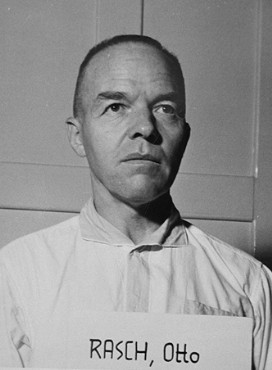 Otto Rasch of Einsatzgruppe C during the Einsatzgruppen trial in Nuremberg. Source: U.S. National Archives.
Otto Rasch of Einsatzgruppe C during the Einsatzgruppen trial in Nuremberg. Source: U.S. National Archives.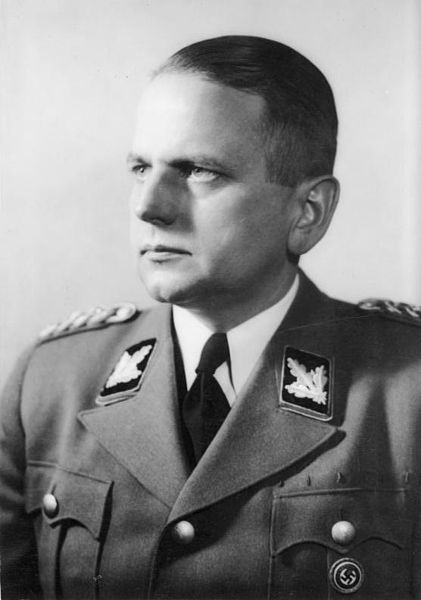 Otto Ohlendorf of Einsatzgruppe D. Source: Bundesarchiv.
Otto Ohlendorf of Einsatzgruppe D. Source: Bundesarchiv.Training and assignment
From May 1941 the members of the Einsatzgruppen were being prepared for their deployment on the eastern front at the Academy of Borderpolice in Pretzsh at the river Elbe, approximately 93,21 miles southwest of Berlin. Because the accommodation being too cramped, part of the personnel was housed in neighbouring Bad Düben and Bad Schmiedeberg. In addition to military training the men were lectured about Russia, the "Russian mentality", the partisan war and the diseases against which they had to protect themselves in the East. In June the leaders of the Einsatzgruppen were instructed by Reinhard Heydrich personally about their task at the Eastern Front, but what exactly was said remains unknown. Orders for mass executions were not put on paper. Prior to their departure the members of the Einsatzgruppen were addressed by Heydrich and SS-Gruppenführer Bruno Streckenbach, who was responsible for the recruitment and training of the members of the Einsatzgruppen. What exactly was communicated has not been recorded either but Heydrich is supposed to have spoken in vague terms only. He warned the men that a "task of a toughness never shown before" was awaiting them.
A note by Heydrich to the Hohere SS und Polizeiführer (HSSPF) of the occupied areas in the East, dated 2 July, 1941, provides more clarity about the persons that had been marked for execution by the Einsatzgruppen. The following targets were named:
- All officials of the Komintern together with the communist professional politicians in general;
- National and local officials (high, medium and radical cadre) of the communist party;
- Volkskommisare (people’s commissioners); Jews in the communist party and in government service and other radical elements (saboteurs, propagandists, snipers, murderers, agents provocateurs etc.)
Heydrich had ordered the leaders of the Einsatzgruppen in advance to secretly incite the local population of the Soviet-Union to launch pogroms against the Jewish population. In the course of the American military tribunal in Nuremberg in 1947/48 against 24 commanders of the Einsatzgruppen, the defendants declared that they also had received orders beforehand to kill the Jewish population. The prime defendant, Otto Ohlendorf, former commander of Einsatzgruppe D, argued that, before departure he was informed orally: "that in the theatre of operations of the Einsatzgruppen on Russian territory the Jews had to be eliminated, just like the political commissioners of the Soviets". Karl Jäger, the former commander of Einsatzkommando 3 of Einsatzgruppe A, during the preliminary hearing of his trial in 1959, referred to a meeting in Berlin of approximately 50 SS officers (which he claimed took place several weeks before the invasion of the Soviet-Union), where Reinhard Heydrich was supposed to have announced that in case of war with Russia, the Jews would have to be shot. Several historians however are of the opinion that these SS officers wanted to save their own skins by hiding behind so-called superior orders, while in reality they themselves gradually took the initiative to execute Jews regardless of age or gender.
It is certain that prior to Operation Barbarossa, no detailed plan existed to eliminate all European Jews. The Jews in Germany and in territories annexed and occupied by Germany had so far indeed been faced with various discriminating measures. For example, Jews were forbidden to have sexual relations with non-Jews and they were no longer allowed to make use of public facilities. Up to 31 October 1941, under pressure of bullying and fearing for their future, approximately 537,000 Jews emigrated from the German Reich, including Austria and the Protectorate of Bohemia and Moravia. Plans by the Nazis to deport all remaining Jews to a Jewish reservation - to be established on Madagascar, in Palestine or in eastern Poland - seemed logistically impossible to achieve. With the imminent invasion of the Soviet-Union it did mean however that the number of Jews under Nazi-rule would only increase. After the invasion of Poland, the number of Jews had already grown to more than 2 million and the Soviet-Union acccounted for at least 5 million more.
On 31 July 1941, several weeks after the invasion of the Soviet-Union, Reichsmarshall Hermann Göring (Bio Göring) granted Heydrich full authority "to make all necessary preparations regarding […] the total solution of the Jewish question within the sphere of influence of Germany in Europe." Heydrich was ordered to send Göring "an all-encompassing plan with regard to the organizational, factual and material measures required for the realization of the desired final solution of the Jewish question (Endlösung) at short notice". What the ‘final solution’ meant exactly was still unknown at that moment but the activities of the Einsatzgruppen on the eastern front promised no good at all.
Definitielijst
- Einsatzgruppen
- "Taskforces of Deployment Squads". Special units composed of various SS and police services under supervision of the Reichssicherheitshauptamt (RSHA). Einsatzgruppen were deployed during the invasion of Poland in 1939 and during operation Barbarossa in 1941. In 1939 these units were ordered to eliminate the Polish intelligentsia. In the Soviet Union they were deployed to execute various political and racial enemies of the Third Reich, like Jews, gypsies and communists. The "Holocaust by bullets" in the Soviet Union was the horrendous first act of the eventual "final solution".
- Endlösung
- Euphemistic term for the final solution the Nazis had in store for the “Jewish problem”. Eventually the Endlösung would get the form of annihilating the entire Jewish people in extermination camps.
- invasion
- Armed incursion.
- Jäger
- Also called fighter plane. Fighter planes can be used for air defence (armed with guns and/or carrying guided missiles) or for tactical purposes (armed with nuclear or conventional bombs or rockets). The aircraft used for tactical purposes are also called fighter- bombers because they are bombers with the speed and manoeuvrability of a fighter. Tactical fighters, equipped with photographic equipment are also used as reconnaissance plane.
- Jews
- Middle Eastern people with own religion that lived in Palestine. They distinguished themselves by their strong monotheism and the strict observance of the Law and tradition. During World War 2 the Jewish people were ruthlessly persecuted and annihilated by the German Nazis. . An estimated 6,000,000 Jews were exterminated.
- Nazi
- Abbreviation of a national socialist.
Images
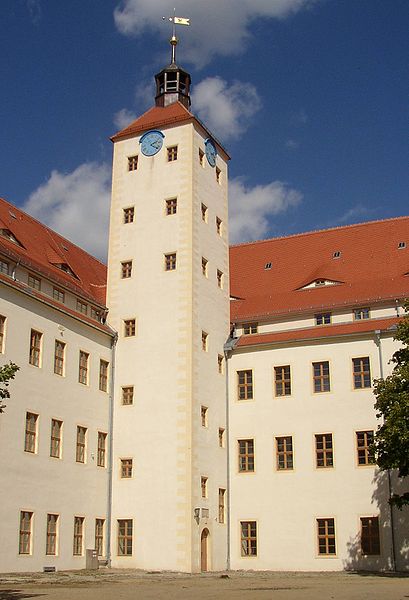 The castle in Pretzsch, home of the police academy Source: Doris Antony.
The castle in Pretzsch, home of the police academy Source: Doris Antony.Start of the mass murders
On 22 June 1941 the Wehrmacht invaded the Soviet-Union. The conflict between the two dictatorial states had begun. The frontline troops of the Wehrmacht were followed closely by members of the Einsatzgruppen traveling by truck, motor cycle and staff car. The Einsatzkommandos and Sonderkommandos operated very independently, separated from the general staff. Some Kommandos advanced up to the front line, while other Kommandos carried out operations in the rear areas. Advance units sometimes ended up fighting the Red Army.
Commanders of the Wehrmacht sometimes utilized Kommando units operating at the front, to clear an area of partisans and snipers. Furthermore the Einsatzgruppen engaged in capturing government buildings and securing documents of the NKVD for example, the Soviet intelligence service but it was already clear from the beginning that execution was their main task. Without any distinction, Jews including those who had nothing to do with the Red Army, the Communist party or the Soviet government, all were important targets from the start. Initially, mainly grown-up Jewish males were the victims of executions, but after a few weeks or months, the switch would be made to exterminate entire Jewish communities, including women and children.
Before the invasion of the Soviet-Union there seems to have been no question about an unequivocal order to exterminate all Soviet Jews. The Einsatzgruppen started killing Jewish women and children in addition to the grown-up men at various points in time, varying from late July until early September 1941. They acted on the basis of local circumstances and their interpretation of individual orders and the Nazi ideology. Prior to the invasion, Hitler and other Nazi leaders had portrayed the Jews as the ultimate enemy. On 22 June 1941 the day German troops launched the invasion, Hitler declared: "The hour has come in which it is unavoidable that we enter the arena against the Jewish-Anglosaxon warmongers and the Jewish rulers of the Bolshevic center in Moscow." A consequence of depicting the war against the Soviet-Union as a battle of destruction of the "Jewish Bolshevism" was that the Jews as an entire population, would fall victim to extermination.
An implicite indication that Jewish women and children had to be killed as well was given by Heinrich Himmler on 28 July, 1941 to two SS-cavalryregiments, SS-Kavalerie-Regiment 1 and 2, which were engaged in the fight against "partisans" in the swamp area near Prypjat in the Ukraine. These units did not belong to the Einsatzgruppen however, but were supervised by the Höhere SS- und Polizeiführer (HSSPF) in Central Russia, Erich von dem Bach-Zalewski. Himmler ordered them to shoot, apart from partisans, Jewish men as well and to drive their wives into the marshes. Although this was never formulated in so much detail, it may be assumed that Himmler expected that they would perish in there all by themselves. On 18 September, 1941, SS cavalry commander Hermann Fegelein (who was to marry Eva Braun’s sister in 1944) reported that during the operation in the swamp area, 14,178 looters, 1001 partisans and 699 Russian prisoners of war had been executed; with "looters" he probably meant mainly Jews. Earlier on, SS-Sturmbannführer Franz Magill, commander of the SS-Kavalerie Regiment 2 had already reported that driving the women and children into the marshes did not "provide the desired result, as the marshes were not deep enough for them to sink into."
Instead of Jewish women and children being driven into the swamps, they would soon be suffering the same fate as the men after the invasion of the Soviet-Union. In the summer of 1941, Himmler and Heydrich visited their subordinates at the eastern front several times and on those occasions they are supposed to have stimulated the mass murders without any regard to age or gender. Between June and September 1941, SS-Oberführer Erwin Schulz, commander of Einsatzkommando 5 of Einsatzgruppe C, declared that on 10 or 12 August 1941, his immediate superior, SS-Brigadeführer Dr. Otto Rasch, had given the order that Jewish women and children had to be executed, unless they could be employed as forced laborers. In this way it was prevented that any future "revengers" would remain behind. Again, the order was given by SS-Obergruppenführer Friedrich Jeckeln, the Höhere SS- und Polizeiführer in southern Russia, who in turn received the order from Himmler. On 27 and 28 August in Kamenets-Podolsky in the western Ukraine and commanded by Jeckeln, the largest mass murder so far took place. 23,600 Jews, including women and children were killed by Jeckeln’s troops. Among the victims were at least 14,000 Jews who had been deported from Hungary shortly before.
Definitielijst
- cavalry
- Originally the designation for mounted troops. During World War 2 the term was used for armoured units. Main tasks are reconnaissance, attack and support of infantry.
- Einsatzgruppen
- "Taskforces of Deployment Squads". Special units composed of various SS and police services under supervision of the Reichssicherheitshauptamt (RSHA). Einsatzgruppen were deployed during the invasion of Poland in 1939 and during operation Barbarossa in 1941. In 1939 these units were ordered to eliminate the Polish intelligentsia. In the Soviet Union they were deployed to execute various political and racial enemies of the Third Reich, like Jews, gypsies and communists. The "Holocaust by bullets" in the Soviet Union was the horrendous first act of the eventual "final solution".
- ideology
- A collection of principles and ideas of a certain system.
- invasion
- Armed incursion.
- Jews
- Middle Eastern people with own religion that lived in Palestine. They distinguished themselves by their strong monotheism and the strict observance of the Law and tradition. During World War 2 the Jewish people were ruthlessly persecuted and annihilated by the German Nazis. . An estimated 6,000,000 Jews were exterminated.
- Nazi
- Abbreviation of a national socialist.
- Red Army
- Army of the Soviet Union.
- Regiment
- Part of a division. A division divided into a number of regiments. In the army traditionally the name of the major organised unit of one type of weapon.
- Wehrmacht
- German armed military forces, divided in ground forces, air force and navy.
Images
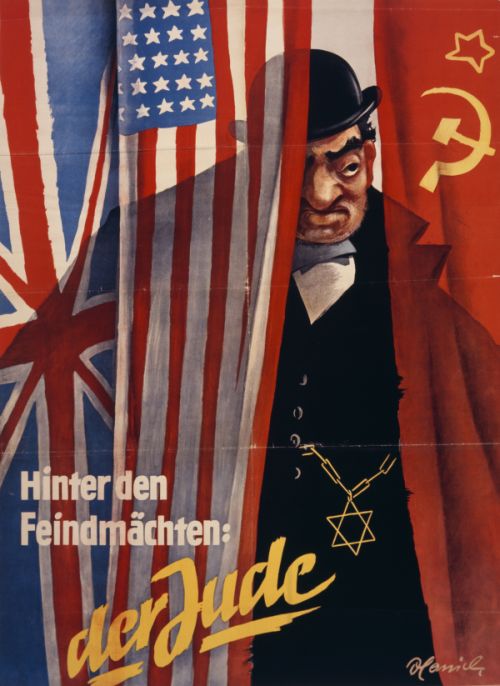 German propaganda poster Source: U.S. Holocaust Memorial Museum.
German propaganda poster Source: U.S. Holocaust Memorial Museum.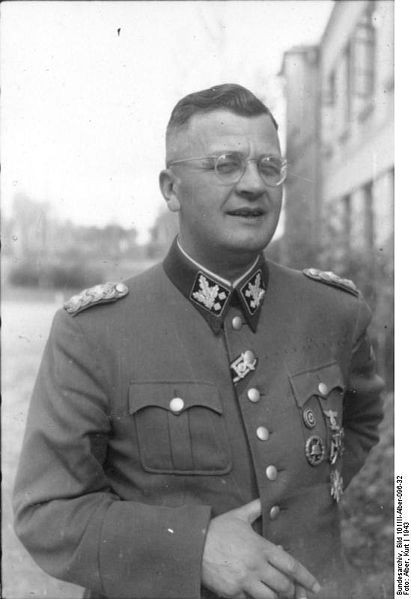 Höhere SS- und Polizeiführer Erich von dem Bach-Zalewski, 1943. Source: Bundesarchiv.
Höhere SS- und Polizeiführer Erich von dem Bach-Zalewski, 1943. Source: Bundesarchiv.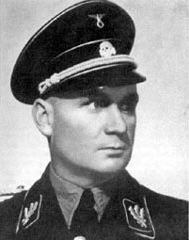 Höhere SS- und Polizeiführer Friedrich Jeckeln. Source: www.vernetztes-gedaechtnis.de.
Höhere SS- und Polizeiführer Friedrich Jeckeln. Source: www.vernetztes-gedaechtnis.de.The Baltic states
Between June 1941 and March 1942, Einsatzgruppe A commanded by SS-Brigadeführer Franz Walter Stahlecker was active in the Baltic States, where a large part of the population had welcomed the Wehrmacht as liberators after a year of Soviet occupation. The Jews in these countries were faced with prosecution immediately after the invasion by the Germans. In Lithuania, the southernmost Baltic state, Einsatzgruppe A was supported by local collaborators who carried out pogroms. Before the German occupation in Lithuania, the Jewish population numbered 210,000. The extermination of the Lithuanian Jews was carried out by Einsatzkommando 3 of Einsatzgruppe A commanded by SS-Standartenführer Karl Jäger. In the capital city of Vilnius, the operational area of Einsatzkommando 3 coincided at first with that of Einsatzkommando 9 of Einsatzgruppe B commanded by SS-Obersturmbannführer Alfred Filbert. Because of its large Jewish population of approximately 70,000, the city was also known as "the Jerusalem of the north". In July Einsatzkommando 9, assisted by Lithuanian collaborators, killed 5,000 Jews from Vilnius in the forest near Ponar, about 6,21 miles from the capital. Until August 1944 72,000 Jews from Vilnius and surroundings had been executed on this location as well as many thousands of non-Jewish Poles and Lithuanians.
Another important murder site in Lithuania was situated in Kaunas/Kovno. This second largest city of Lithuania was occupied by the Germans on the 24th of June 1941. Mass executions were carried out by Einsatzkommando 3 from 4 July 1941 onwards, in the Fortresses IV, VII and IX which were situated outside of town and which formed part of a chain of reinforcements dating from the nineteenth century. Mainly Jews were murdered in this location. For instance, on 6 July, the execution of 2.514 Jews was reported. Initially, the majority of the victims consisted of Jewish males while children were still spared, but this changed on 26 September 1941, when in Fort IV 412 Jewish men, 615 women and 581 children were killed, using the pretence they were ill. The largest execution took place on October 9th, 1941, when the ghetto of Kaunas was cleared of so called "superfluous" Jews and in Fort IX 2,007 men, 2,920 women and 4,237 children were killed. In November, approximately 5,000 Jews from the German Reich (Berlin, Munich, Frankfurt am Main, Vienna and Breslau) would be murdered here as well.
On 1 December 1941, SS-Standartenführer Karl Jäger, commander of Einsatzkommando 3 reported that the task of his Einsatzkommando in Lithuania was completed. A total of 137,346 executions had been carried out in different locations, the majority of the victims being Jew. "There are no more Jews in Lithuania," Jäger wrote in his final report which has become known as the "Jäger report". 34,500 Jewish laborers and their families remained and were housed in ghettos, yet many of them would be killed later on.
Just like Lithuania, Latvia also quickly fell in German hands after the invasion of the Soviet-Union. Approximately 70,000 Jews lived in Latvia at the beginning of the occupation. Units of Einsatzgruppe A were assisted in the executions by the so called Arajs Kommando, an auxiliary policeforce commanded by the Latvian SS-officer Viktor Arajs. Between July and October 1941, approximately 34,000 Jews were killed in Latvia, including 4,000 from Riga. Important murder sites were situated in the forests of Bikernieki and Rumbula, both very near Riga. The Höhere SS- und Polzeiführer for northern Russia and the Baltic States , Friedrich Jeckeln, who had been responsible earlier for the mass murders in Kamenets-Podolski, had been charged with the extermination of the remaining Jews in the ghetto of Riga. On 30 November and 8 December, 1941, he had them transported to the small pine forest of Rumbula, 7,46 miles south of Riga where they were executed by members of Einsatzgruppe A, assisted by the Arajs Kommandos. During the operation which became known as the Jeckeln Aktion, 25,000 Jews were killed, among them 1,000 Jews from the German Reich. Later in the war, yet more Latvian Jews were murdered, leaving hardly any survivors when the country was liberated by the Red Army.
In comparison with Lithuania and Latvia relatively few Jews lived in Estonia. Because the country was occupied by the Wehrmacht only in August 1941, many Jews had managed to flee. The murder of the remaining 1,000 Jews was carried out by Sonderkommando 1a of SS-Standartenführer Martin Sandberger (Bio Sandberger), assisted by members of the Estonian militia. On 12 October, 1941, Sandberger reported that so far 440 Jews had been executed. That winter the remaining Jews who initially had been employed as slave laborers, would be killed as well. In January 1942, Estonia was "free" of Jews (Judenfrei). In addition, Sonderkommando 1a and the Estonian militia executed 5,000 non-Jewish Estonians as well during the first year of the occupation, because they had been accused of collaboration with the Russians.
Definitielijst
- collaboration
- Cooperation of the people with the occupying forces, more generally spoken the term for individuals who cooperate with the occupying force is collaborator.
- ghetto
- Part of a town separated from the outside world to segregate Jewish population. The establishment of ghettos was intended to exclude the Jews from daily life and from the rest of the people. From these ghettos it was also easier to deport the Jews to the concentration and extermination camps. Also known as “Judenviertel” or Jewish quarter.
- invasion
- Armed incursion.
- Jäger
- Also called fighter plane. Fighter planes can be used for air defence (armed with guns and/or carrying guided missiles) or for tactical purposes (armed with nuclear or conventional bombs or rockets). The aircraft used for tactical purposes are also called fighter- bombers because they are bombers with the speed and manoeuvrability of a fighter. Tactical fighters, equipped with photographic equipment are also used as reconnaissance plane.
- Jews
- Middle Eastern people with own religion that lived in Palestine. They distinguished themselves by their strong monotheism and the strict observance of the Law and tradition. During World War 2 the Jewish people were ruthlessly persecuted and annihilated by the German Nazis. . An estimated 6,000,000 Jews were exterminated.
- Red Army
- Army of the Soviet Union.
- Wehrmacht
- German armed military forces, divided in ground forces, air force and navy.
Images
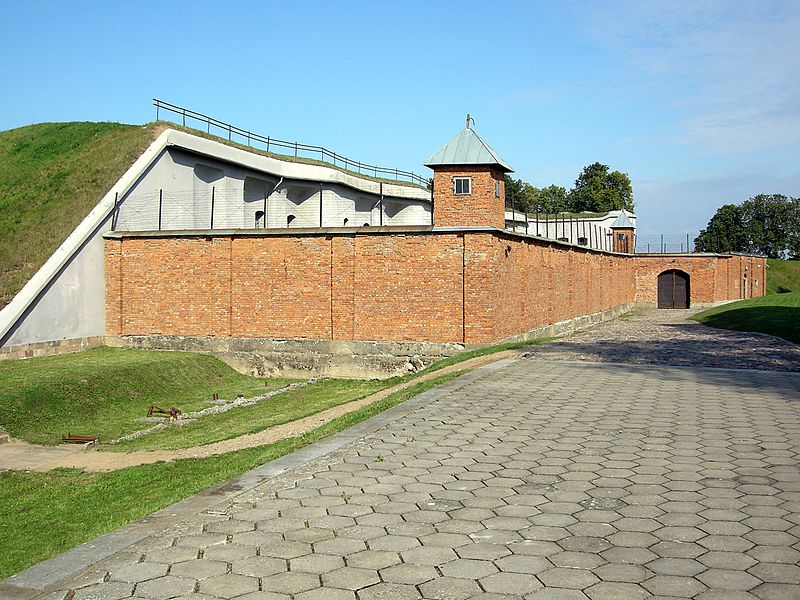 Fort IX in Kaunas in Lithuania today. Source: Andrius Vanagas.
Fort IX in Kaunas in Lithuania today. Source: Andrius Vanagas.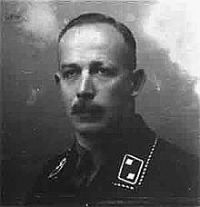 Karl Jäger, commander of Einsatzkommando 3 and author of the "Jäger report". Source: www.olokausters.org.
Karl Jäger, commander of Einsatzkommando 3 and author of the "Jäger report". Source: www.olokausters.org.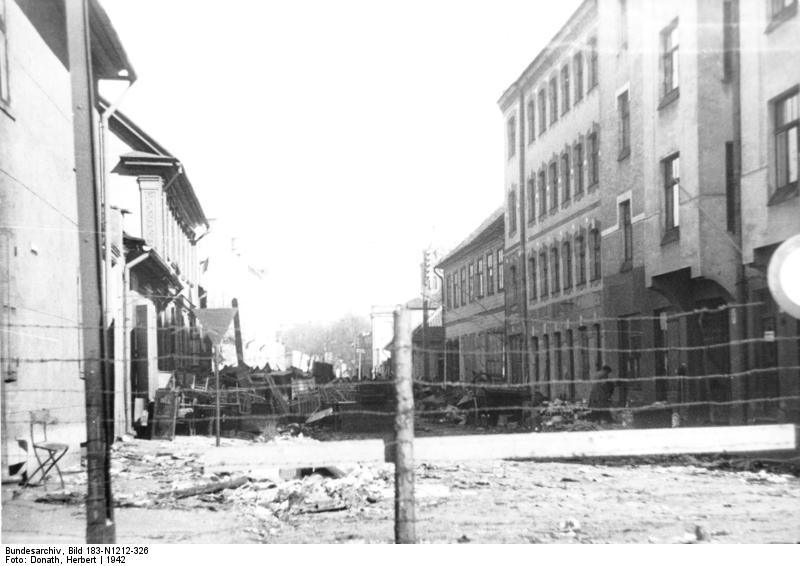 The ghetto in Riga, 1942. Source: Bundesarchiv.
The ghetto in Riga, 1942. Source: Bundesarchiv.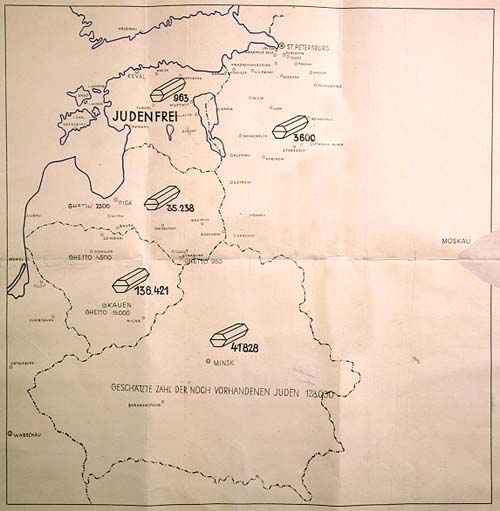 Report of Stahlecker of 31 January 1942 amouncing the result of executions in the Baltic States:. Estonia is free of Jews. Source: U.S. National Archives.
Report of Stahlecker of 31 January 1942 amouncing the result of executions in the Baltic States:. Estonia is free of Jews. Source: U.S. National Archives.Byelorussia and the Ukraine
Until October 1941, Byelorussia was the territory of Einsatzgruppe B command by SS- Gruppenführer Arthur Nebe, the head of the German criminal investigation department (Kripo). In 1939, 375,000 Jews lived in Byelorussia (within its borders at that time). This number had increased during 1941 after an influx of Jewish refugees from Poland. Especially in eastern Byelorussia many Jews had managed to flee farther from the Germans towards the east in time. During the first weeks of the invasion the first executions took place. In July 1941 for example, Einsatzgruppe B reported 200 Jews killed in Vlejka 332 in Vitebisk, 150 - 200 Jewish men in Gorodok, 900 male Jews between the age of 18 and 65 years and 215 Jewish and Bolshevik government officials in Bialystok (which would become part of Poland again after the war) and 381 Jews in Baranavitsjy. On July 5th, 1941, Nebe and his staff reached Minsk where he established his headquarters for two weeks. During his stay there 1.050 Jews would be executed.
Like elsewhere in the Soviet-Union, ghettos were established in Byelorussia for the Jewish population. On 19 August, 1941, Einsatzkommando 8 of Einsatzgruppe B, commanded by SS-Sturmbannführer Otto Bradfisch murdered 3,726 Jews from the ghetto of Mahiljow/Mogilev. By the end of October of that year, the remaining Jews were killed and the ghetto was closed down. The same thing happened in other ghettos in Byelorussia at that time, except in Minsk, where the ghetto would remain until October 1943. At its peak, this ghetto would number 100,000 inhabitants, including Jews from the German Reich; the majority would not survive the war however.
On August 5th, a month after his arrival in Minsk, Nebes’ headquarters was relocated again, this time to Smolensk in Russia. From Smolensk Nebe commanded the Vorkommando Moskau which had orders to clear Moscow and surroundings from Jews. The Vorkommando however never reached Moscow as the Wehrmacht offensive aimed at the city, Operation Typhoon, launched on 2 October, 1941, failed dismally and Moscow would never be captured by the Germans. While the German tanks got bogged down in the quackmire caused by the autumn rains which turned the roads to Moscow into rivers of mud, Einsatzgruppe B reported that at that time the total number of recorded liquidations amounted to 45,467.
The advance of Einsatzgruppe C started in southern Poland and the region of Galicia, which is shared today by Poland and Ukraine. Further towards the east Einsatzgruppe C discovered that a large part of the Ukrainian Jews (1,533,000 within the borders before 1939) had fled to the east. As Germany occupied the largest part of the country as late as October 1941 and before news about the mass murders had reached the Ukraine, many Jews had grabbed their chance to flee. From the German point of view that was no problem. On September 12, 1941, Einsatzkommando 6 of Einsatzgruppe C reported: "The dislodgment of hundreds of thousands of Jews, as we understood in many cases past the Ural, has cost us not one penny and makes an important contribution to the solution of the Jewish question in Europe." Nevertheless, Jews had stayed behind In several places in the Ukraine. After the mass execution of 23,600 Jews by Friedrich Jeckeln on 27 and 28 August in Kamenets-Podolski in the western Ukraine, on 29 and 30 September, a mass murder also took place in Kiev which took two full days. In the ravine of Babi Jar/Babi Yar situated outside the city, 33,771 Jews were killed by Sonderkommando 4a, commanded by SS-Standartenführer Paul Blobel (Bio Blobel).
Afterwards, Einsatzgruppe C advanced further eastwards. Between 23 September and 4 October, 1941, Einsatzkommando 5 executed 85 political officials, 14 persons found guilty of sabotage and looting and 179 Jews in Dnjepopretovsk. On 13 October men of the Höhere SS- und Polizeifüherer Friedrich Jeckeln killed 10,000 Jews on the same location. Later that autumn Einsatzkommando 6 murdered another 1,000 Jews and later that year Einsatzgruppe C was active in Charkov/Kharkov. According to the civil registration, 10,271 Jews still remained in the city. On 14 December, 1941, they were called up in order to walk the next day under extremely harsh winter conditions to a deserted tractor factory just outside town where they were held prisoner under miserable conditions. In January 1942 they were marched to a nearby ravine called Drobyzkyj Jar/Drobitsky Yar in groups to be executed by men of Einsatzkommando 4a, assisted by a battalion of the Ordnungspolizei and Ukrainian collaborators.
The southernmost part of the Soviet-Union (the southern Ukraine, Bessarabia, the Crimea and the Caucasus) was the territory of Einsatzgruppe D commanded until July 1942 by SS-Gruppenführer Otto Ohlendorf. The first executions were carried out in the Bessarabia region, which Hitler had assigned to the Romanian dictator Ion Antonescu. Einsatzgruppe D succeeded in killing between 150,000 and 160,000 Jews in July and August 1941 in cooperation with the Romanian army and the Wehrmacht. In the southern Ukrainian port of Odessa, immediately after the town had been captured on 16 October, 1941, Einsatzkommando 11b and the Romanian army murdered 8,000 inhabitants, mainly Jews. On 22 October, in reprisal for the demolition of the Romanian military headquarters 19,000 Jews were taken to the harbor and burned alive by order of Antonescu. Another 20,000 were executed outside the city. In the meantime Einsatzgruppe D advanced towards Nikolajev/Mykolajiv and Cherson/Kherso in the southern Ukraine, in total 5,000 Jews were killed in these cities. Thereafter, in Melitopol in the southeastern Ukraine 2,000 Jews were executed and 8,000 in Marioepol/Mariupol. Afterwards they advanced further across the Crimean peninsula on the heels of the Wehrmacht and in November 1941, Sonderkommando 11b killed 11,000 Jews in anti-tank ditches outside Simferopol. In August 1942 Sonderkommando 10a murdered thousands of Jews in Krasnodar near Georgia in southeastern Russia.
Definitielijst
- Babi Yar
- A ravine northwest of the Ukranian capital Kiev. On 29 and 30 September 1941, 33,771 Jews were killed and dumped into the ravine by Sonderkommando 4a under command of Paul Blobel.
- ghetto
- Part of a town separated from the outside world to segregate Jewish population. The establishment of ghettos was intended to exclude the Jews from daily life and from the rest of the people. From these ghettos it was also easier to deport the Jews to the concentration and extermination camps. Also known as “Judenviertel” or Jewish quarter.
- invasion
- Armed incursion.
- Jews
- Middle Eastern people with own religion that lived in Palestine. They distinguished themselves by their strong monotheism and the strict observance of the Law and tradition. During World War 2 the Jewish people were ruthlessly persecuted and annihilated by the German Nazis. . An estimated 6,000,000 Jews were exterminated.
- Kripo
- Kriminalpolizei. Criminal investigation agency. Ordinary civilian police of Nazi Germany.
- Odessa
- Organisation of Former SS-members. Secret organization of and for former SS-members. Organised new identities and housing abroad after the war.
- offensive
- Attack on a smaller or larger scale.
- Wehrmacht
- German armed military forces, divided in ground forces, air force and navy.
Images
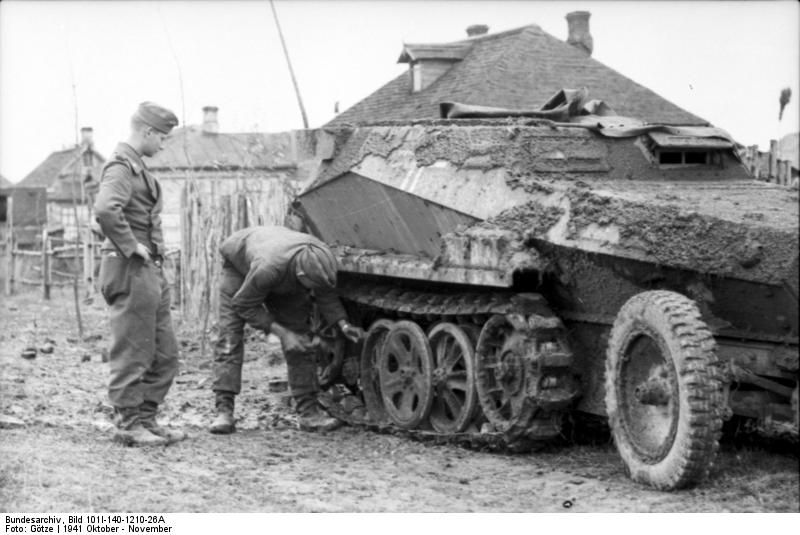 The roads to Moscow turned into a quagmire, autumn of 1941 Source: Bundesarchiv.
The roads to Moscow turned into a quagmire, autumn of 1941 Source: Bundesarchiv.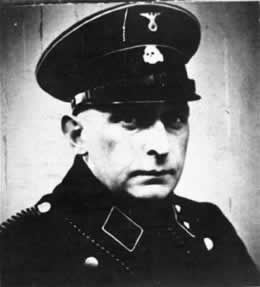 Paul Blobel, commander of Sonderkommando 4a Source: U.S. Holocaust Memorial Museum.
Paul Blobel, commander of Sonderkommando 4a Source: U.S. Holocaust Memorial Museum.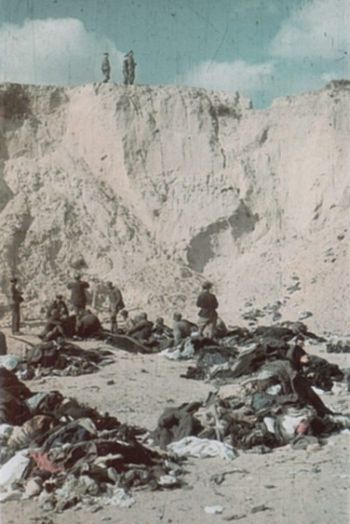 The ravine of Babi Jar after the mass murder. Source: Deathcamps.org.
The ravine of Babi Jar after the mass murder. Source: Deathcamps.org.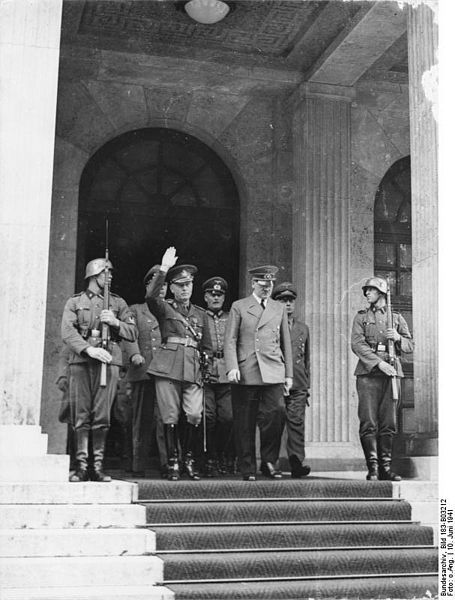 Hitler with Romanian dictator Ion Antonescu in Munich, 10 June 1941. Source: Bundesarchiv.
Hitler with Romanian dictator Ion Antonescu in Munich, 10 June 1941. Source: Bundesarchiv.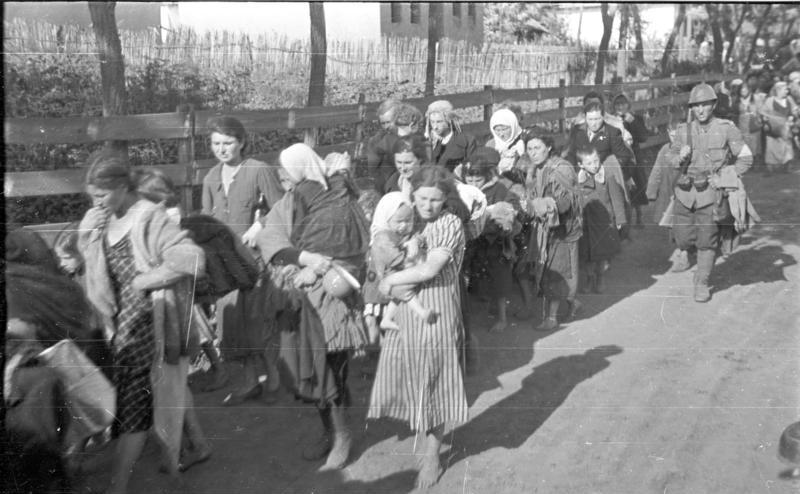 Romanian soldiers deporting Jews in the Soviet-Union, 17 July 1941. Source: Bundesarchiv.
Romanian soldiers deporting Jews in the Soviet-Union, 17 July 1941. Source: Bundesarchiv.Methods of killing
During the early phase of the German invasion the Jews in the western Soviet-Union did not generally fear the Germans. Religious Jews rejected Soviet rule because of the anti-religion policy, such as the ban on celebrating the Sabbath. Many Jews were oriented more towards the German culture rather than the Russian and they still remembered the correct treatment by the Germans they had enjoyed in the First World War. Early in the invasion, there may even have been Jews who had welcomed the German army as liberators. Thanks to the treaty between Hitler and Stalin, the Nazi crimes against the German and Polish Jews had been kept quiet in the Soviet-Union since 1939. The Soviet Jews were therefore not prepared for what was waiting for them when messages about mass executions reached them. This made it easy for the Einsatzgruppen to arrest them but later in the war the Einsatzgruppen also succeeded in misleading their victims. In Kiev and Charkov, for instance, by distributing pamphlets, Jews were called up to report the next day, allegedly for relocation (Umsiedlung). The call was answered willingly, causing the victims, mostly without them knowing it, to go to their death voluntarily.
The method of operation the various units of Einsatzgruppen used in their murder activities varied slightly, but on average, the same procedure was followed everywhere. The execution sites were mostly to be found away from inhabited areas, often in woods a few miles away from a village or city. Jews in for instance Kiev and Charkov were forced to walk to their execution site. They were transported by truck to other locations. On arrival, they had to hand over their valuables like money and jewelry and to undress down to their underwear or were totally naked. Their valuables and clothing were confiscated for the benefit of the German Reich, but corrupt members of the Einsatzgruppen or their local helpers often took possession of their valuables, even though risking severe punishment. Subsequently, the victims were taken to the execution site in groups.
Sometimes the graves had been dug by themselves beforehand, but often existing dug-outs were used such as anti-tank ditches and bomb craters, or as in Babi Jar and Drobyzkyj Jar, ravines.
The Einsatzgruppen used different methods of execution. Some commanders preferred to make the victims stand at the edge of the ditch and to kill them by means of a shot in the back of the neck. Others preferred executions from a distance, whereby the members of a firing squad shot one single victim simultaneously so it was unclear who fired the fatal shot. The purpose was to lessen the psychological pressure on the members of the squad. A method often used was called the sardine-pack (Sardinenpackung) which was applied for the first time by Friedrich Jeckeln at the mass murder in Kamenets-Podolsky. Victims were forced to lay flat on their stomach on the bottom of the mass grave and were subsequently shot in the back of the neck. The next group of victims had to lay down in the opposite direction on top of this layer of bodies and were executed in the same way. This procedure was repeated until the grave was completely filled up, like a tin of sardines. In order to make it easier for the victims to lay down, a thin layer of sand was often spread over the corpses. It has been said that young Ukrainian girls were used to flatten these layers of sand with their bare feet. "Many Jews were only wounded," one of these girls remembers; "It was difficult to walk on them."
The commanders of the Einsatzgruppen recorded the numbers of executions in reports (the so-called Ereignismeldungen, see Progress report UdSSR 106) which were sent to RSHA headquarters in Berlin. In order to justify the murders, it was often argued that they had been necessary as a reprisal for resistance and arson. Instead of calling them murder actions, euphemisms were used such as Sonderaktionen (special actions) or Aussiedlung [deportation] etc.. On 1 August, 1941, Gestapo chief Heinrich Müller issued orders that these reports had to be forwarded to Adolf Hitler.
In spite of the fact that mass executions were mostly carried out away from inhabited areas, it happened more than once that local inhabitants and soldiers of the Wehrmacht were watching what was going on. A major of the Wehrmacht witnessed a mass execution in the neighbourhood of Zjytomyr/Zhitomir in the Ukraine in late July 1941. He reported that "many soldiers, some of them in bathing suits, stood watching the bloodbath around the ditch in which the executions took place. An equally large number of civilians, including women and children, was also present." Other murder sites were better protected, for example Babi Jar which was sealed off to spectators by the Wehrmacht. In principle the executions had to remain secret, especially for the home front. In this they failed as many Germans obtained knowledge about the mass murders that took place at the eastern front by mail and stories of soldiers on leave.
Himmler imposed a ban on taking pictures of the mass murders by German soldiers and the SS dealt with Germans violating this rule. In 1943 for instance, SS-Sturmführer Max Täubner, the commander of a workshop of the Waffen-SS in the Ukraine was indicted by the SS-und Polizei Gericht in Munich for, among other things, having shown such photographs to his wife and friends. "Such photos may constitute a serious risk to the security of the Reich when they fall in the wrong hands," the court ruled. "They could easily leak out and be used as propaganda by the enemy". The defendant was found guilty of this and most of the other charges and sentenced to 10 years imprisonment, even though he was pardoned later in the war.
Resistance by the victims seldom arose during the executions. The unarmed men, but certainly the children, women, the elderly and the ill could do nothing against their armed murderers. In order to save themselves from more misery and to bring a quick end to torture and fear it was better to follow the instructions of the perpetrators. It happened more than once however that the victims were not fatally wounded or even not at all and managed to escape from the mass grave, often by pretending to be dead, lying for hours between their deceased family members, friends and neighbours. Once escaped, the survivors still had to try and stay alive in a hostile environment with the continuous risk of being betrayed by the local population.
Definitielijst
- Einsatzgruppen
- "Taskforces of Deployment Squads". Special units composed of various SS and police services under supervision of the Reichssicherheitshauptamt (RSHA). Einsatzgruppen were deployed during the invasion of Poland in 1939 and during operation Barbarossa in 1941. In 1939 these units were ordered to eliminate the Polish intelligentsia. In the Soviet Union they were deployed to execute various political and racial enemies of the Third Reich, like Jews, gypsies and communists. The "Holocaust by bullets" in the Soviet Union was the horrendous first act of the eventual "final solution".
- First World War
- Took place from 1914 till 1918 and is also named The Great War. The conflict started because of increased nationalism, militarism and neo-colonialism in Europe. Two alliances battled one another during the 4-year war, which after a dynamic start, resulted into static trench warfare. The belligerents were the Triple Alliance (consisting of Great-Britain, France, and Russia; later enlarged by Italy and the USA, amongst others) on the one hand and the Central Powers (consisting of Germany, Austria-Hungary, Bulgaria and the Ottoman empire) on the other hand. The war was characterized by the huge number of casualties and the use of many new weapons (flamethrowers, aircraft, poison gas, tanks). The war ended in 1918 when Germany and its allies surrendered unconditionally.
- invasion
- Armed incursion.
- Jews
- Middle Eastern people with own religion that lived in Palestine. They distinguished themselves by their strong monotheism and the strict observance of the Law and tradition. During World War 2 the Jewish people were ruthlessly persecuted and annihilated by the German Nazis. . An estimated 6,000,000 Jews were exterminated.
- Nazi
- Abbreviation of a national socialist.
- propaganda
- Often misleading information used to gain support among supporters or to gain support. Often used to accomplish ideas and political goals.
- resistance
- Resistance against the enemy. Often also with armed resources.
- RSHA
- Reichssicherheitshauptamt. The central information and security service of the Third Reich.
- Waffen-SS
- Name of Military section of the SS.
- Wehrmacht
- German armed military forces, divided in ground forces, air force and navy.
Images
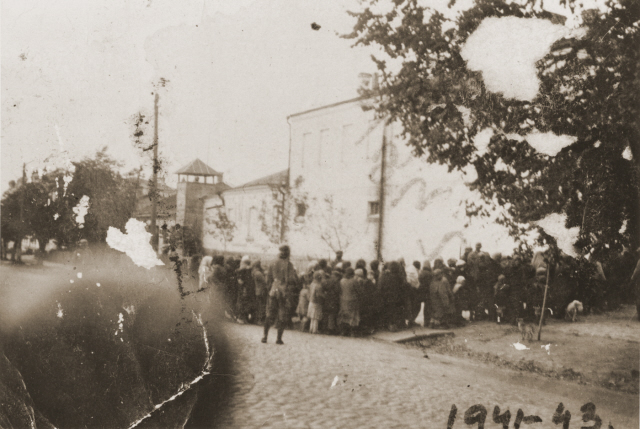 Jews being marched to the execution site at Kamenets-Podolski. Source: U.S. Holocaust Memorial Museum.
Jews being marched to the execution site at Kamenets-Podolski. Source: U.S. Holocaust Memorial Museum.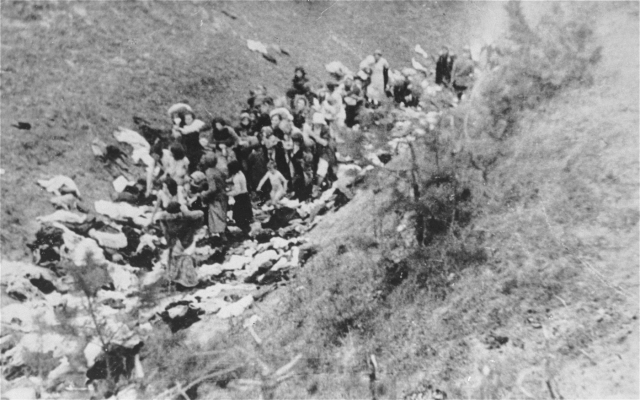 Jewish women and children from the ghetto of Mizocz in Ukraine are being forced to undress preceding their execution. Source: U.S. Holocaust Memorial Museum.
Jewish women and children from the ghetto of Mizocz in Ukraine are being forced to undress preceding their execution. Source: U.S. Holocaust Memorial Museum.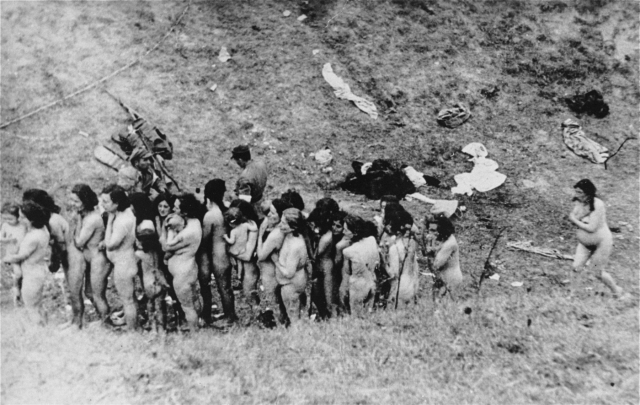 Once undressed they are being herded off to the place of their execution. Source: U.S. Holocaust Memorial Museum.
Once undressed they are being herded off to the place of their execution. Source: U.S. Holocaust Memorial Museum.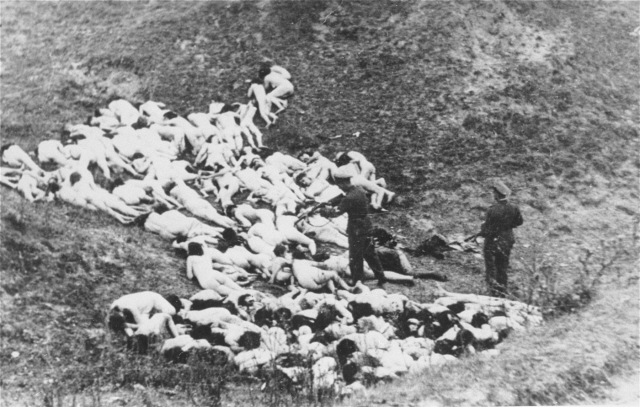 After they laid down, they were executed. Source: U.S. Holocaust Memorial Museum.
After they laid down, they were executed. Source: U.S. Holocaust Memorial Museum.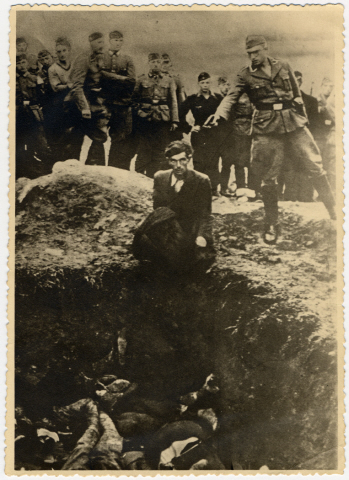 Men of the Waffen-SS and the Reichsarbeitsdienst watch an execution in the Ukraine. Source: U.S. Holocaust Memorial Museum.
Men of the Waffen-SS and the Reichsarbeitsdienst watch an execution in the Ukraine. Source: U.S. Holocaust Memorial Museum.Local collaborators
The intention was that a large part of the mass murder of the Jews would be carried out by the local non-Jewish inhabitants by means of spontaneous pogroms. "The impression had to be created, that the local population had taken the first steps on their own initiative as a natural reaction to the long years of suppression by the Jews and the more recent terror by the communists", as Franz Walter Stahlecker stated in a report of October 1941. It would transpire however that such self-cleaning actions, as he called it, did not occurr very often and only very seldom spontaneously. Pogroms were almost always organized by the Einsatzgruppen after stirring up the local population first. Most acts of violence by civilians against Jews were of short duration. They started after the arrival of the Einsatzgruppen and usually ended when the Wehrmacht took control. The German military administration had no stomach for long-term local unrest. Within the Einsatzgruppen resistance also existed against the chaotic and bloody eruptions of violence by the local population as they preferred rigidly orchestrated executions. Nonetheless, an estimated 20.000 Jews were killed in pogroms during the first days of the German invasion.
In the Baltic states the Nazis counted on the fact that pogroms could easily be launched. The anti-Semitism had been fired up during the Soviet-occupation which had lasted for about a year before the German invasion. During that year members of the local elite and nationalists had fallen victim to Soviet-terror by arrests, deportations and executions. The Jewish minorities had been encouraged by the Soviet administration to contribute to the establishment of new Soviet states. The atheist Soviet government, contrary to earlier governments, did not distinguish between Jews and Christians; this made the Jews feel attracted to communism and thus they were well represented in the current Communist administration. After the German invasion, the entire Jewish population had to atone for this.
In Lithuania the pogroms were mainly the responsibility of a group of partisans commanded by the Lithuanian collaborator Algirdas Klimaitis. Earlier on, these partisans had taken up arms against the Red Army and were thereafter stimulated by Einsatzgruppe A to act against Jews which led to a large eruption of violence, especially in Kaunas/Kovno. "In the night of 25 to 26 June over 1,500 Jews were murdered by Lithuanian partisans, many synagogues were burned down or destroyed in other ways and a Jewish quarter of about 60 houses was set ablaze. During the next nights 2,300 more Jews were exterminated," Stahlecker reported. Elsewhere in Lithuania 1,200 Jews were killed by Klimaitis’ men in similar actions.
In Latvia Stahlecker experienced more difficulties in stimulating pogroms than in Lithuania. In his opinion, the reason was that all national leaders had been killed or deported by the Soviets and thus could not be used to incite the population to take action. Nevertheless, Einsatzgruppe A succeeded in inciting the Latvian auxiliary police to a pogrom, in the course of which all synagogues in Riga were destroyed and approximately 400 Jews killed. Under the direction of the Latvian nationalist Viktor Arajs, Jews were burned alive in a synagogue in Riga in early July 1941. In Estonia pogroms did not materialize; the nationalist Estonian militia, the Omakaitse did kill several Communists on its own initiative. The Estonian militia though was deployed by Sonderkommando 1a to carry out executions.
While in Byelorussia there were no pogroms either, in the border region of Poland and the Ukraine, especially in Galicia, several pogroms took place. In July 1941 in the small town of Jedwabne, which is approximately 43,50 miles north west of Bialystok, at least 340 Jews were slaughtered by fellow inhabitants of Polish descent. In Lviv/Lvov, the city in Galicia called Lemberg by the Germans and which is part of the Ukraine today, Einsatzgruppe C stimulated local Ukrainian collaborators to launch a pogrom against the Jews, which lasted several days. The Ukrainians were incited to this by the discovery of 2,500 dead prisoners in the prison of the NKVD, the secret service of the Soviet-Union. The victims, nationalists of Ukrainian and other descent had been executed by the secret service prior to the German invasion. The Jewish inhabitants were to atone for this, as they were accused of collaboration with the Soviet administration. In July thousands of Jews and also Poles fell victim to the violence in Lvov.
In the nearby town of Boryslaw/Boryslav a pogrom also took place in the same period, after corpses of young men, killed by the NKVD had been found. The commanding general of the Wehrmacht had the local inhabitants have their way for 24 hours with taking revenge on the Jews who allegedly had been involved in the murders by the Soviet secret service. With everything they could lay their hands on, like axes and hammers, the Jews were beaten to death. In Kremenets a similar action of revenge took place. The local Soviets had murdered 100 to 150 Ukrainians. A rumor circulated to the effect that some of them had been killed by throwing them in kettles with boiling water. Early July 1941, the Ukrainians took revenge by rounding up 130 Jews and bludgeoning them to death. In Tarnopol and Czortków/Chrotkiv pogroms took place as well. Einsatzgruppe C however was not satisfied with the willingness of the local people to use violence against Jews and reported: "The cautious way which was chosen at that time to stimulate pogroms against the Jews, was less successful as had been hoped for. […] A clear cut anti-Semitism based on racial or spiritual views however is foreign to these people".
Both in the Baltic States as in Byelorussia and the Ukraine local militia were deployed as auxiliary police forces. These played an important role in the arrests and executions. So-called Volksdeutschen, ethnic Germans who lived in the Soviet-Union, were also recruited for these supporting units. The exact number of locals collaborating with the Einsatzgruppen is unknown but runs into the thousands or tens of thousands. In numerous cases, especially in Byelorussia and the Ukraine, the number of local helpers supporting the mass murders even exceeded the number of German members of the Einsatzgruppen. These local collaborators had to their advantage that they were familiar with the language of the victims, they knew the environment well, they knew where the Jews lived and that they could better convince their countrymen to betray their neighbours. In addition, they were often used to carry out the dirty work, like participating in the firing squads. The local collaborators were not only motivated by anti-Semitism, but also by the hope that by collaborating with the Germans, their country would remain independent, which turned out to be an illusion.
The majority of the indigenous population however took a passive attitude towards the operations of the Einsatzgruppen. They feared they would be next to be murdered or did not dare to support the Germans as they feared that the Soviets would return and then it would be their turn to be punished for collaboration with the enemy. Although many did not show any interest in the fate of the Jews at all, there were in fact civilians in the occupied Soviet-Union who did help Jews to survive the war. In January 2012, for example, 2,402 non-Jewish Ukrainians were designated "Righteous among the Peoples" by Yad Vashem, the Israeli Holocaust Institute, an award for non-Jews for having rescued Jews during the Second World War.
Definitielijst
- collaboration
- Cooperation of the people with the occupying forces, more generally spoken the term for individuals who cooperate with the occupying force is collaborator.
- communism
- Political ideology originating from the work of Karl Marx “Das Kapital” written in 1848 as a reaction to the so-called class struggle between the proletariat (labourers) and the bourgeoisie. According to Marx the proletariat would take over power from the well-to-do classes though a revolution. The communist movement aspires an ideal situation where the means of production and the means of consumption are common property of all citizens. This should end poverty and inequality (communis = common).
- Einsatzgruppen
- "Taskforces of Deployment Squads". Special units composed of various SS and police services under supervision of the Reichssicherheitshauptamt (RSHA). Einsatzgruppen were deployed during the invasion of Poland in 1939 and during operation Barbarossa in 1941. In 1939 these units were ordered to eliminate the Polish intelligentsia. In the Soviet Union they were deployed to execute various political and racial enemies of the Third Reich, like Jews, gypsies and communists. The "Holocaust by bullets" in the Soviet Union was the horrendous first act of the eventual "final solution".
- Holocaust
- Term for the destruction of European Jewry by the Nazis. Holokauston is the Greek term for a completely burnt sacrifice.
- invasion
- Armed incursion.
- Jews
- Middle Eastern people with own religion that lived in Palestine. They distinguished themselves by their strong monotheism and the strict observance of the Law and tradition. During World War 2 the Jewish people were ruthlessly persecuted and annihilated by the German Nazis. . An estimated 6,000,000 Jews were exterminated.
- Red Army
- Army of the Soviet Union.
- resistance
- Resistance against the enemy. Often also with armed resources.
- synagogue
- Jewish house of prayer.
- Wehrmacht
- German armed military forces, divided in ground forces, air force and navy.
- Yad Vashem
- Yad Vashem is Israel’s national Holocaust memorial where in addition to Jewish victims and resistance heroes, also non-Jewish helpers of Jews during the World War 2 are being honoured. Those non-Jewish are called the Righteous Among The Nations. Until the mid 90’s trees were planted for these rescuers. In 1996 a special remembrance garden was established displaying all of the names of the helpers. Every year new names are added.
Images
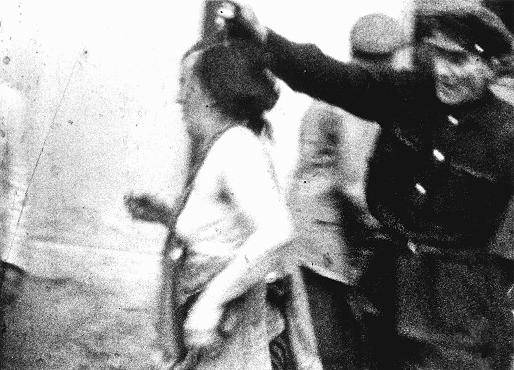 Picture taken during a pogrom in Lviv, 1941. Source: U.S. National Archives.
Picture taken during a pogrom in Lviv, 1941. Source: U.S. National Archives.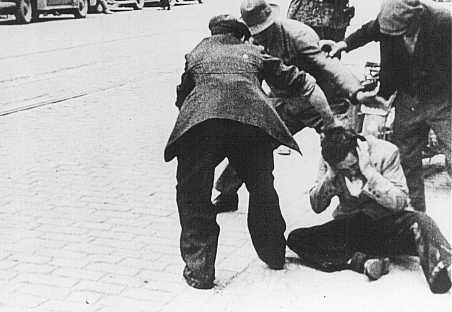 Ukrainian men maltreating a Jewish inhabitant of Lviv during a pogrom, 1941. Source: U.S. National Archives.
Ukrainian men maltreating a Jewish inhabitant of Lviv during a pogrom, 1941. Source: U.S. National Archives.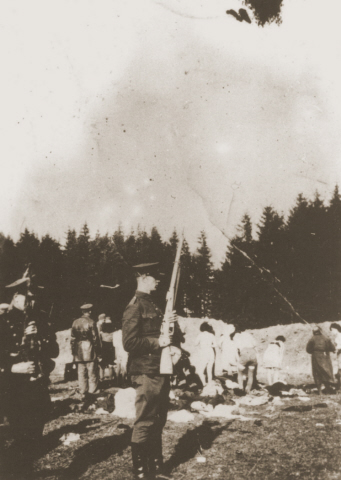 Lithuanian members of militia force Jewish women to undress before their execution, summer 1941. Source: U.S. National Archives.
Lithuanian members of militia force Jewish women to undress before their execution, summer 1941. Source: U.S. National Archives.Other culprits
The Einsatzgruppen were not the only ones responsible for the genocide on Jews in the Soviet-Union. A large contribution to the mass murders was made by SS and police forces serving under the Höhere SS- und Polizeiführer who were responsible, within their districts, for the occupied territories. They were:
- Hans Adolf Prützmann for "Ostland und Russland-Nord" (The Baltic States and northern Russia)
- Erich von dem Bach-Zelewski for "Russland-Mitte und Weissruthenien" (Central Russia and Byelorussia)
- Friedrich Jeckeln for "Russland-Süd" (Southern Russia).
Prützmann and Jeckeln changed positions at the end of 1941 as Heinrich Himmler was dissatisfied with the slow pace with which Prützmann organized the extermination of Jews in Latvia. Contrary to Prützmann, Jeckeln was a skilled mass murderer, as he had demonstrated in Kamenets-Podolski in the Ukraine where, under his direction, 23,600 Jews were murdered in two days. After his transfer and under his direction, the Jews from the ghetto in Riga were killed in a similar way during the Jeckeln Aktion on 30 November and 7 December 1941in the forest of Rumbula.
The SS-Kavalerie-Brigade under supervision of Erich van dem Bach-Zelewski was responsible for the mass murder of Jews in the marshes near Prypjat in the Ukraine. He commanded the Polizei-Regiment Mitte of the Ordnungspolizei as well, which was involved in such actions as the murder of 2,278 Jews in Minsk on 31 August and 1 September 1941 as well as the execution of 3,726 Jews in Mahiljow/Mogilev on 19 October 1941. Elsewhere in the occupied territories in the East, units of the Ordnungspolizei were also actively involved in the mass murder of Jews. Companies of Polizei-Batallion 9, later on relieved by Polizei-Batallion 3 also from Berlin, operated as part of the Einsatzgruppen.
Other police units operated independently however. Polizei-Batallion 309 for instance was guilty of a mass slaughter in Bialystok, Byelorussia. Right after the occupation of the city on 27 June, 1941, the German police officers arrested Jewish men in the Jewish quarter. Approximately 300 were executed in the city in open air, while another 700 to 800 were driven into the synagogue which was subsequently set ablaze. Victims trying to flee from the blazing building were shot. When the fire spread to adjacent buildings still more Jews were killed. Around 12 July Polizei-Batallion 322 and Polizei-Batallion 309, supervised by Von dem Bach-Zelewski executed at least 3,000 Jews from Bialystok in the tank ditches outside the city.
The members of the police units had been regular police officers in Germany. The American historian Christopher Browning investigated Reserve-Polizei-Batallion 101 which was active in the Lublin area in Poland and gave his book the self-explanatory title "Ordinary Men"(1992).
Also involved in the mass murder of Jews in the Soviet-Union, was SS-unit Sonderkommando Dirlewanger. This military unit, commanded by the sadistic Oskar Dirlewanger and mainly consisting of convicted criminals, became notorious for its cruelty. It was sent to Byelorussia in February 1942 to fight partisans which in practice turned to mass slaughter, claiming the lives of at least 30,000 civilians, including Jews who had managed to escape from Einsatzgruppe B.
Then there was the Romanian army of dictator Ion Antonescu which was responsible for killing between 280,000 and 380,000 Jews in Bessarabia, Boekovina and Transnistria; mostly on their own initiative but sometimes assisted by German units as well. Victims included many Jews who had earlier been deported from Romania. Otto Ohlendorf, commander of Einsatzgruppe D which operated in the same area, complained about the chaotic way the executions were carried out by the Romanian army. According to him, widespread corruption occurred and sadistic violence was practiced at will, apart from inefficiency.
Definitielijst
- Batallion
- Part of a regiment composed of several companies. In theory a batallion consists of 500-1,000 men.
- Brigade
- Consisted mostly of two or more regiments. Could operate independently or as part of a division. Sometimes they were part of a corps instead of a division. In theory a brigade consisted of 5,000 to 7,000 men.
- Browning
- American weapon’s designer. Famous guns are the .30’’ and .50’’ machine guns and the famous “High Power” 9 mm pistol.
- Einsatzgruppen
- "Taskforces of Deployment Squads". Special units composed of various SS and police services under supervision of the Reichssicherheitshauptamt (RSHA). Einsatzgruppen were deployed during the invasion of Poland in 1939 and during operation Barbarossa in 1941. In 1939 these units were ordered to eliminate the Polish intelligentsia. In the Soviet Union they were deployed to execute various political and racial enemies of the Third Reich, like Jews, gypsies and communists. The "Holocaust by bullets" in the Soviet Union was the horrendous first act of the eventual "final solution".
- ghetto
- Part of a town separated from the outside world to segregate Jewish population. The establishment of ghettos was intended to exclude the Jews from daily life and from the rest of the people. From these ghettos it was also easier to deport the Jews to the concentration and extermination camps. Also known as “Judenviertel” or Jewish quarter.
- Jews
- Middle Eastern people with own religion that lived in Palestine. They distinguished themselves by their strong monotheism and the strict observance of the Law and tradition. During World War 2 the Jewish people were ruthlessly persecuted and annihilated by the German Nazis. . An estimated 6,000,000 Jews were exterminated.
- Regiment
- Part of a division. A division divided into a number of regiments. In the army traditionally the name of the major organised unit of one type of weapon.
- synagogue
- Jewish house of prayer.
Images
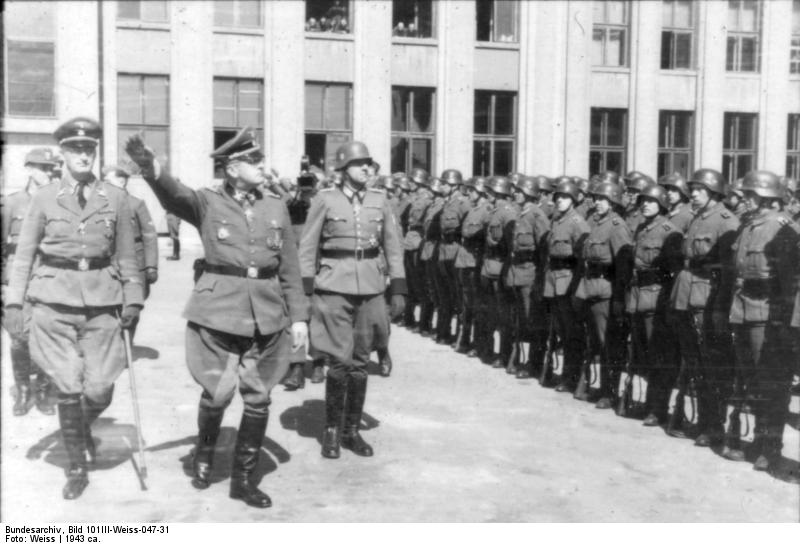 Erich von dem Bach-Zelewski inspecting troops of the Ordnungspolizei in Minsk, 1943. Source: Bundesarchiv.
Erich von dem Bach-Zelewski inspecting troops of the Ordnungspolizei in Minsk, 1943. Source: Bundesarchiv.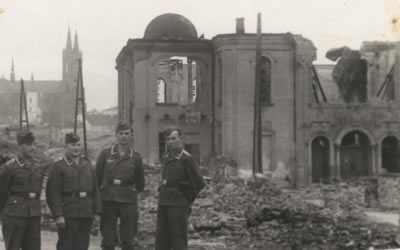 German soldiers posing in front of the burned down synagogue in Bialystok, 1941. Source: The Jewish magazine.
German soldiers posing in front of the burned down synagogue in Bialystok, 1941. Source: The Jewish magazine.Co-operation with the Wehrmacht
The co-operation between the Wehrmacht and the Einsatzgruppen in the Soviet-Union went along without big problems. Several commanders of the Einsatzgruppen praised the mutual collaboration. "I can say that the co-operation with the Wehrmacht in general was good from the beginning", Franz Walter Stahlecker concluded, "and in some cases, for example with the 4. Panzerarmee of General Erich Höppner, very close, you could even say warm". Within the Wehrmacht Franz Halder, Chief of the Oberkommando des Heeres, (O.K.H.,Supreme Command of the Army) praised the Einsatzgruppen for guarding the communication and supply lines in the area of the front, freeing military personnel from these tasks.
While in Poland there had been complaints from the army leadership about the violent conduct of the SS, on the eastern front there was no question of serious protest at all. On the contrary, many of the senior officers approved the actions against the Jews. Generalfeldmarschall Walter von Reichenau (Bio Von Reichenau), commander of 6. Armee, issued orders to his troops on 10 October, 1941 in which he declared that "the campaign against Jewish Bolshevism was not an ordinary war. In the East the soldier is not only a fighter according to the rules of combat but also […] the avenger of all bestialities the German and associated peoples have suffered from. Hence, the soldier must fully understand the necessity of the harsh but justified atonement of the Jewish Untermenschen (subhumans)" he stated. In his view, the purpose of these harsh measures against the Jews were "to knock down the revolts behind the back of the Wehrmacht which, as we have learned from experience, are always initiated by the Jews".
As the Nazi-leaders as well as the army leadership continuously pointed out that the war in the East was as much a battle against Communism as against Jewry and by equating Jews to partisans, understanding for the mass murders grew among soldiers of the Wehrmacht. Soldiers wrote approvingly about the mass murders in their letters to the home front. "The great task on our shoulders in the battle against Bolsjevism lies in the extermination of the eternal Jewry" a front soldier wrote in a letter home. "If you see what the Jews have caused here in Russia, you begin to really understand why the Führer has gone into battle against Jewry. What harm would have been done to our fatherland if those beasts would have gained the upper hand?"
Sometimes however there was disapproval, for example when staff officers of Heeresgruppe Mitte laid their eyes on a report about the slaughter of 6,500 Jewish men, women and children on 20 and 21 October, 1941, in Barysaw/Borisov, Byelorussia. Earlier information about the execution of grown up male Jews had not made too much of an an impression, but the execution of women and children was a step too far for the officers. As a result, several of them, including Generalmajor Henning von Tresckow and Leutnant Fabian von Schlabrendorf would become involved in the attempt on the life of Hitler and the coup d’état of the 20th of July, 1944, as their disdain of this genocide grew.
A case in Bila/Byelaya Tserkov, a town south of Kiev is characteristic for the attitude of the Wehrmacht towards the mass murder of the Jews. In August 1941, hundreds of Jewish men and women were killed here by men of Einsatzgruppe C. Some 90 children, aged between 0 and 9 years were left alive and locked up without food, drink or supervision in a building at the edge of town. A Reformed and a Roman Catholic chaplain complained to their superiors about the dreadful circumstances they found the children in. The matter was brought to the attention of 1 Generalstabsoffizier Helmuth Groscurth of the 295. Infanterie-Division. On 21 August, he drafted a critical report argueing that the children should have been executed right away so "this inhumane torture" would have been avoided. Von Reichenau was also informed and he ordered Paul Blobel to execute the children forthwith. The execution was carried out by Ukrainian collaborators commanded by SS-Obersturmführer August Häfner. He remembers: "The crying of the children was indescribable; I will never forget the scene for the rest of my life […] I especially remember a small blond haired girl, holding my hand. She also was shot later on.[…] Many children were hit four or five times before they died." Groscurth received disciplinary punishment for his action and In 1943 he was made prisoner of war in Stalingrad; he died in Soviet imprisonment.
In many cases the Wehrmacht was activiley involved in the mass murder of Jews, sometimes in collaboration with an Einsatzgruppe, but also of their own accord. German military personnel assisted in the arrest of Jews and guarded execution sites. Army commanders kept in close touch with leaders of the Einsatzgruppen and sometimes they decided together on what should happen to the local Jewish population. The decision about killing the Kiev Jews in Babi Jar was jointly taken with Generalmajor Kurt Eberhard, the commander of Feldkommandantur 195, as a reprisal for the explosions in the buildings where his artillery staff as well as his headquarters were housed. Other commanders went even further, like Generalmajor Gustav von Bechtolsheim, commander of the 707. Infanterie-Division in Byelorussia; he ordered his men to exterminate Jews independently or in co-operation with the SS. In Byelorussia 19,000 persons, mainly Jews, were killed by the 707. Infanterie-Division and the SS in the fall of 1941 and the winter of 1942.
Proof of further co-operation between the SS and the army was obvious in the implementing of the Kommissarbefehl mentioned earlier. The Wehrmacht recorded 2,252 executions being carried out by themselves pursuant to this order, but probably many more political commissioners of the Red Army were handed over to and killed by the Einsatzgruppen. The Wehrmacht also granted special teams entry into their prisoner of war camps. These teams made selections and arrested political officers, active Communists, Jews and so on. Big misunderstandings occurred regularly when for example Muslims were mistaken for Jews, as they were both circumcised and owing to the limited knowledge of ranks and badges of the Red Army, buglers were sometimes mistaken for political officers. At least 50,000 Jewish prisoners of war and as many non-Jewish prisoners of war were executed by the Einsatzgruppen.
Definitielijst
- collaboration
- Cooperation of the people with the occupying forces, more generally spoken the term for individuals who cooperate with the occupying force is collaborator.
- Communism
- Political ideology originating from the work of Karl Marx “Das Kapital” written in 1848 as a reaction to the so-called class struggle between the proletariat (labourers) and the bourgeoisie. According to Marx the proletariat would take over power from the well-to-do classes though a revolution. The communist movement aspires an ideal situation where the means of production and the means of consumption are common property of all citizens. This should end poverty and inequality (communis = common).
- Einsatzgruppen
- "Taskforces of Deployment Squads". Special units composed of various SS and police services under supervision of the Reichssicherheitshauptamt (RSHA). Einsatzgruppen were deployed during the invasion of Poland in 1939 and during operation Barbarossa in 1941. In 1939 these units were ordered to eliminate the Polish intelligentsia. In the Soviet Union they were deployed to execute various political and racial enemies of the Third Reich, like Jews, gypsies and communists. The "Holocaust by bullets" in the Soviet Union was the horrendous first act of the eventual "final solution".
- Führer
- German word for leader. During his reign of power Adolf Hitler was Führer of Nazi Germany.
- Heeresgruppe
- The largest German ground formation and was directly subordinate to the OKH. Mainly consisting of a number of “Armeen” with few directly subordinate other units. A Heeresgruppe operated in a large area and could number several 100,000 men.
- Jews
- Middle Eastern people with own religion that lived in Palestine. They distinguished themselves by their strong monotheism and the strict observance of the Law and tradition. During World War 2 the Jewish people were ruthlessly persecuted and annihilated by the German Nazis. . An estimated 6,000,000 Jews were exterminated.
- Nazi
- Abbreviation of a national socialist.
- Red Army
- Army of the Soviet Union.
- Wehrmacht
- German armed military forces, divided in ground forces, air force and navy.
Images
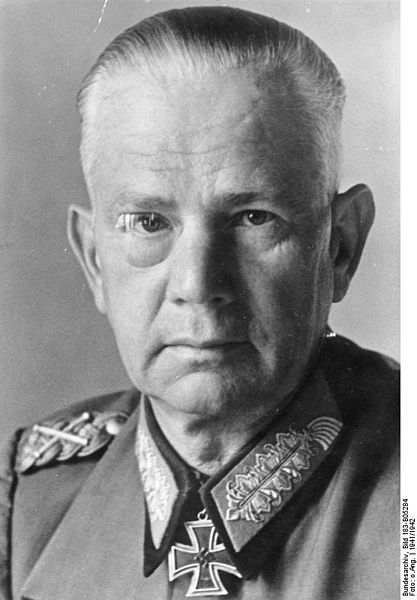 Generalfeldmarschall Walter von Reichenau Source: Bundesarchiv.
Generalfeldmarschall Walter von Reichenau Source: Bundesarchiv.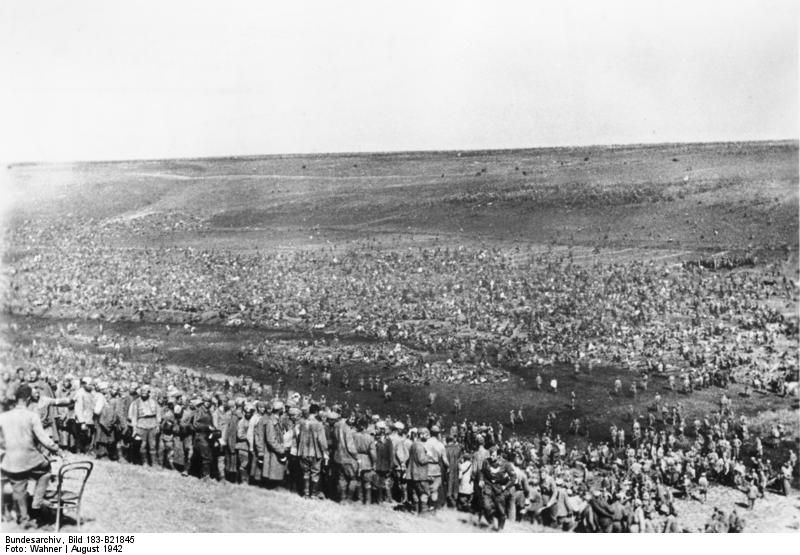 An improvised PoW camp for soldiers of the Red Army. Einsatzgruppen carried out selections in such camps. Source: Bundesarchiv.
An improvised PoW camp for soldiers of the Red Army. Einsatzgruppen carried out selections in such camps. Source: Bundesarchiv.Adaptation of the methods of killing
The mass executions did not remain without consequences for the perpetrators. In eyewitness accounts after the war, many complained about how hard their task had been; as for instance Kurt Werner, member of Sonderkommando 4a who had participated in the mass murder in the ravine of Babi Jar near Kiev. He spent an entire morning at the bottom of the grave where the executions took place. "I still remember the total misery of the Jews when they reached the rim of the ravine and saw the bodies," he declared. "Many Jews were crying out loud in death agony. It is impossible to imagine what kind of steel nerves were required to carry out this dirty job down there. It was horrible". In order to make the work bearable it was carried out in shifts and teammembers were lavishly provided with alcohol. Nevertheless, many suffered from psychosomatic complaints and sick leave was high. Some culprits even had to be sent on leave back to Germany because of nervous breakdowns. That for example happened to Paul Blobel, commander of Sonderkommando 4a. Others had seen enough and had themselves transferred, like Walter Blume, commander of Sonderkommando 7a, who, as early as September 1941, returned to a desk job in the personnel department of the RSHA. Contrary to what many members of the Einsatzgruppen stated after the war, it was indeed possible to dodge the service.
Heinrich Himmler himself was faced with the psychological stress his men experienced in carrying out executions during a working visit to Minsk on 15 August, 1941. On his own request he watched the execution of more than a hundred prisoners including many Jews. This was carried out by Einsatzkommando 8 of Einsatzgruppe B in a forest north of Minsk. Others present confirmed that Himmler was nervous and when two female victims were not dead immediately after the first shots, it became too much for him. He is said to have jumped up, shouting to the commander of the firing squad: "Don’t torture these women! Hurry up! Hurry up and kill them!" After they had finished the SS-Führer made a speech to the executioners in which he stated, according to Von dem Bach-Zalewski who was also present "that it would certainly not please him when German men liked this type of job. But it should not disturb their consciousness in the least, as they were soldiers who were expected to carry out any order without questioning. […] Only he was responsible to God and the Führer for whatever had to be done". Later on during his visit, Himmler ordered Arthur Nebe, commander of Einsatzgruppe B, to find a killing method which would be less stressful for the psyche of the executioners.
Together with Dr. Albert Widmann, a chemist of the Kriminaltechnisches Institut der Sicherheitspolizei (KTI) (Insitute for forensic research) Nebe carried out experiments with various methods of killing in September 1941. Mental patients were used as guinea pigs. A first test with explosives in a wood near Minsk proved unsuccessful because things like clearing away the remains of the victims proved to take too much time. A second experiment in an asylum for mental patients in Mahiljow/Mogilev was successful in the eyes of Nebe and Wildmann. The victims were locked in a small chamber and gassed by means of the exhaust gasses fed into the room through tubes from two trucks. The use of exhaust fumes was psychologically less stressful for the operators and more practical as trucks and suitable rooms were available anywhere. The immediate result of these experiments was that mental patients in Mahiljow/Mogilev and Minsk were gassed using this tried and tested method.
Around the same period preparations to commit genocide by means of gassing took place at other locations. In September 1941 the first experiments with gassing using Zyklon-B took place in Auschwitz and in November in the Lublin district, construction of the extermination camp Belzec was begun. The gassing method in the extermination camps Sobibor and Treblinka was identical to the one developed by Nebe and Wildmann. The victims in these camps were gassed in gas chambers with exhaust gasses from powerful engines. The gas chambers in Belzec were ready at the end February 1942 and subsequently the first gassing experiments with deported Jews took place. The gas chambers of Sobibor and Treblinka were operational from May and July 1942 onwards respectively. After the Wannsee conference of 20 January, 1942, the extermination program was carried out on a large scale: hundreds of thousands of European Jews were deported by train to the extermination camps in Poland and subsequently gassed. Apart from this murder method being less stressful for the psyche of the operators, it also saved ammunition and less men were needed to kill a substantial number of Jews simultaneously.
Victims were also gassed by means of exhaust fumes in the so-called gas vans. In the fall of 1941 SS-Obersturmbannführer Walter Rauff, the head of department II D (Technische Angelegenheiten, Technical Affairs) of the RSHA received order from Reinhard Heydrich to modify a truck with a closed cargo hold into a mobile gas chamber. As early as 1940 such a mobile gas chamber had been used by the Nazis to kill mental patients in Poland. At that time the gas was drawn from cylinders but in the new type of gas van the exhaust of the vehicle was connected to the closed hold so the people inside suffocated in the exhaust gasses of the running engine. In the fall of 1941 such gas trucks, also called Spezialwagen (special purpose vehicles) were used in the East for the first time to kill Jews. Even before the end of the year all four Einsatzgruppen in the Soviet-Union made use of these gas trucks.
Definitielijst
- Einsatzgruppen
- "Taskforces of Deployment Squads". Special units composed of various SS and police services under supervision of the Reichssicherheitshauptamt (RSHA). Einsatzgruppen were deployed during the invasion of Poland in 1939 and during operation Barbarossa in 1941. In 1939 these units were ordered to eliminate the Polish intelligentsia. In the Soviet Union they were deployed to execute various political and racial enemies of the Third Reich, like Jews, gypsies and communists. The "Holocaust by bullets" in the Soviet Union was the horrendous first act of the eventual "final solution".
- Führer
- German word for leader. During his reign of power Adolf Hitler was Führer of Nazi Germany.
- Jews
- Middle Eastern people with own religion that lived in Palestine. They distinguished themselves by their strong monotheism and the strict observance of the Law and tradition. During World War 2 the Jewish people were ruthlessly persecuted and annihilated by the German Nazis. . An estimated 6,000,000 Jews were exterminated.
- RSHA
- Reichssicherheitshauptamt. The central information and security service of the Third Reich.
- Wannsee conference
- Conference at the Wannsee on 20 January 1942. The Nazi’s made final agreements about the extermination of Jews in Europe, the Final Solution (Ëndlösung).
- Zyklon-B
- Poison gas that was systematically used in German extermination camps, primarily to murder Jews.
Images
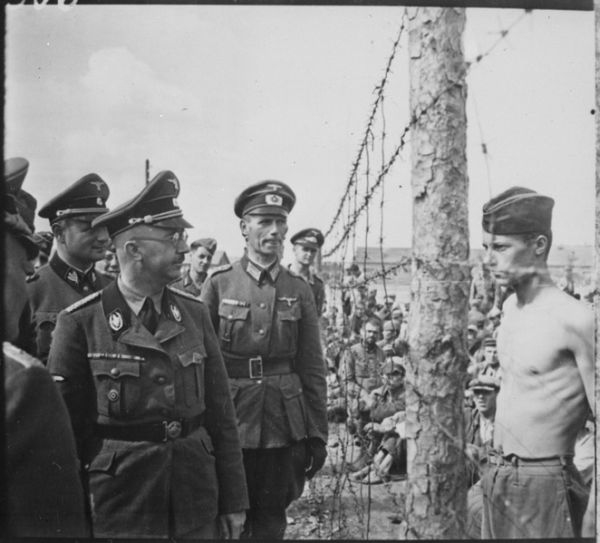 SS-chief Heinrich Himmler visiting a PoW camp in Minsk. Source: U.S. National Archives.
SS-chief Heinrich Himmler visiting a PoW camp in Minsk. Source: U.S. National Archives.After 1941
By the end of 1941, 0.5 million Soviet Jews - a conservative estimate - had been murdered by the Einsatzgruppen and their collaborators. However, within the German occupied part of the Soviet-Union 1.5 million Jews were still alive. A large number of them was enclosed in ghettos in towns like Vilnius and Kaunas in Lithuania, Riga in Latvia and Minsk in Byelorussia. The living conditions in these ghettos were very bad as a consequence of overpopulation. In September 1941 in Vilnius for example, 29,000 Jews were living in a area which before accomodated only 4,000. From the autumn of 1941 onwards, Jews from the German Reich were arriving in the ghettos in the East in addition to the Soviet Jews. In most cases room had been created for them by executing large numbers of Soviet Jews before they arrived.
Jews from the German Reich were executed in Riga and Kaunas in the fall of 1941 as well, although no orders to that effect had been issued. Friedrich Jeckeln had even been reprimanded by Heinrich Himmler for his responsibility for the murder of a trainload of Jews which had arrived on 30 November in Riga from Berlin. The decision that all Jews, including all those from Western Europe were to be killed, would still not be taken until the turn of the year 1941-1942. But even after 1941, not all Jews in the ghettos in the East would be executed immediately, although this was actually demanded by the SS. For the Wehrmacht and the German civilian administration the Jews held an irreplaceable position as forced laborers so in many places Jews, capable of work and their families were saved for the time being. In the Ukraine for example Jews were put to work in constructing Durchgangsstrasse IV, a highway of 1242 miles in length through the Ukraine to the Caucasus, which was to facilitate the supply of men and material for the German army. Tens of thousands of slave laborers died during the construction of the road and an estimated 25,000 Jewish road workers were executed on the spot when they got too exhausted to work any longer.
In spite of the fact that in the fall of 1941 new methods for mass murder had been developed, the Einsatzgruppen remained active until the end of the war. The first wave of killing had come to a halt towards the end of 1941, except for the recently conquered areas on the Crimea and in the direction of the Caucasus where the murders continued without respite until the summer of 1942. In the spring of 1942 Einsatzgruppe C and Einsatzgruppe D cleared various large cities in the east of the Ukraine of Jews, including Horlivka/Gorlovka, Artemivsk and Stalino (today Donetsk). In the Baltic States the second wave of murders started already at the end 1941 and the genocide subsequently expanded over areas further east. A difference with the first wave of murders was that the Einsatzgruppen no longer operated in the front line, but that they engaged in killing the remaining Jews in the occupied territories which were under civilian rule. Moreover, they no longer operated independently but were subordinate to the Höhere SS- and Polizeiführer; the commander of each Einsatzgruppe was now appointed Befehlshaber der Sicherheitspolizei (commander of the security forces). In addition to the Einsatzgruppen, many extra men of the Ordnungspolizei (regular police force) were sent to the east to carry out executions.
After 1942 the advance of Einsatzgruppe C and D came to a halt as the German army was increasingly forced onto the defense. Only a limited part of the Soviet-Union would become occupied so the largest part of the Jews who lived in Russia or those that had fled in that direction would not fall victim to the Einsatzgruppen. From 1943 onwards, as the Red Army reconquered more and more territory which earlier had been captured by Germany, the Einsatzgruppen had to withdraw also.
During World War Two over 1 million Soviet Jews would ultimately be killed and the Einsatzgruppen accounted for the largest number. Women, children, the sick and the aged formed the majority of the victims. Healthy Jewish men were of course called up earlier for the Red Army and privileged and Jews important to society like scientists, students and craftsmen had been evacuated to the East in time by the Soviet authorities.
In the East the Nazis and their collaborators did not only kill Jews, but also tens of thousands of political commissioners, partisans, Roma, Sinti and mental patients. The Einsatzgruppen recorded approximately 8,000 executions of Roma and Sinti. These peoples underwent the same fate as the Jews, as they were considered anti-socials. Psychiatric patients in Germany had already been killed by the Nazis but the euthanasia program had officially been aborted after protests by the churches. In the Soviet-Union the Einsatzgruppen could comb the psychiatric hospitals at will and murder the patients for which gas trucks were also used,.
Apart from the Jews in the Soviet-Union, the Nazis also intended to exterminate all Jews in North-Africa and the Middle East. To that end, Einsatzkommando Ägypten was formed in 1942, commanded by SS-Obersturmbannführer Walter Rauff, the designer of the gas truck. If the desert army of Erwin Rommel (Bio Rommel) had succeeded in conquering Egypt, then the unit would have gained entry into the British mandate of Palestine where yet another half a million Jews or so would have to be murdered. As a result of the developments at the front that would never come about but in that same year Rauff and his Einsatzkommando Tunesien were in fact responsible for the persecution of Jews in Tunisia. Under command of Rauff approximately 5,000 North-African Jews were arrested and interned in 32 forced labor camps where many died from hunger, illnesses, exhaustion, maltreatment by their German guards and by Allied bombs.
In addition to the four Einsatzgruppen which were deployed in the Soviet-Union a few other Einsatzgruppen have existed. These were mainly deployed in battles against partisans in southeastern Europe and Slovakia. Einsatzgruppe H for instance was involved in the suppression of the Slovakian revolt in 1944. The table below shows an overview of these Einsatzgruppen, their commander(s), the army unit to which they were allocated and their theatre of operations.
| Einsatzgruppe E | Ludwig Teichmann, Günther Hermann, Wilhelm Fuchs | 12. Armee | The Balkans/Croatia |
| Einsatzgruppe G | Josef Kreuzer | Black Sea area | |
| Einsatzgruppe Serbien | Wilhelm Fuchs, August Meyszner, Emanuel Schäfer | Heeresgruppe E | Serbia/Belgrade |
| Einsatzgruppe H | Josef Witiska | Slovakia |
Definitielijst
- Einsatzgruppen
- "Taskforces of Deployment Squads". Special units composed of various SS and police services under supervision of the Reichssicherheitshauptamt (RSHA). Einsatzgruppen were deployed during the invasion of Poland in 1939 and during operation Barbarossa in 1941. In 1939 these units were ordered to eliminate the Polish intelligentsia. In the Soviet Union they were deployed to execute various political and racial enemies of the Third Reich, like Jews, gypsies and communists. The "Holocaust by bullets" in the Soviet Union was the horrendous first act of the eventual "final solution".
- Heeresgruppe
- The largest German ground formation and was directly subordinate to the OKH. Mainly consisting of a number of “Armeen” with few directly subordinate other units. A Heeresgruppe operated in a large area and could number several 100,000 men.
- Jews
- Middle Eastern people with own religion that lived in Palestine. They distinguished themselves by their strong monotheism and the strict observance of the Law and tradition. During World War 2 the Jewish people were ruthlessly persecuted and annihilated by the German Nazis. . An estimated 6,000,000 Jews were exterminated.
- Red Army
- Army of the Soviet Union.
- Wehrmacht
- German armed military forces, divided in ground forces, air force and navy.
Aktion 1005
All over the Soviet-Union where the Einsatzgruppen had been active, mass graves were left behind as proof of the mass murders which had taken place. At the extermination camps of Belzec, Sobibor and Treblinka in Poland the corpses of the victims had also been buried in large pits. In the spring of 1942 Reinhard Heydrich decided that all mass graves in the East had to be cleared. This was induced by the fact that corpses in the mass graves near extermination camps generated gasses, due to decay and there was also the risk that groundwater would be polluted by the rotting corpses. Later on fear also played a role in the sense that if Germany would not be able to retain the occupied territories in the East, the Red Army would surely discover the immense numbers of buried corpses. The existence of these mass graves could then be utilized for anti-German propaganda and public opinion in neutral countries and possibly even in Germany itself might turn against the Nazi-regime. Paul Blobel, former commander of Sonderkommando 4a, was appointed leader of this Enterdungsaktion (exhuming operation) in June 1942, which became known as Aktion 1005 or Sonderaktion 1005.
Blobel started his operation together with a small staff in Chelmno in Poland, where since the end of 1941 tens of thousands of Jews from the region of Lodz had been gassed in gas trucks and dumped in mass graves. The bodies were exhumed and subsequently burned in open fires. The pyres were constructed of stacked railway sleepers. The remaining bones were crushed in a special machine and all remains were subsequently reburied in the empty pits. The same method was used in the summer of 1942 in the extermination camp of Sobibor, although these clearing operations were carried out for mainly practical reasons. Due to the high temperatures, decay of the corpses had set in with the result that limbs and smelly gasses rose to the surface. Moreover, the groundwater was being polluted by the decaying corpses. From December 1942 onwards the mass graves in Belzec would be also cleared, followed by those in Treblinka in March 1943.
In the spring of 1943 Blobel started clearing the mass graves in the occupied territories in the Soviet-Union. Sonderkommando 1005 had been established specifically for this purpose. It consisted of members of the Sicherheitspolizei (Security Service) and Ordnungspolizei (regular police forces). Exhuming and burning of the bodies was left to prisoners, mainly Jews. Two units operated in the Ukraine: Sonderkommando 1005A and 1005B, who were active in Kiev (Babi Jar), Dnjepropetrovsk and other locations. In Minsk Blobel’s deputy, Karl Harder commanded Sonderkommando 1005 Mitte. In the Baltic States separate teams were also engaged in Aktion 1005. The operation ran into problems from the start: there was a shortage of gasoline for cremation and because of the fast advancing Red Army, by far not all mass graves could be cleared in time. Blobel and his team would therefore be unable to completely finish their task. That is the reason why, up untill today there are still non-cleared mass graves in Eastern Europe.
Definitielijst
- Aktion 1005
- German secret operation to cover up the traces of mass extermination in the east. The bodies of the victims of the Einsatzgruppen and extermination camps were dug up from the mass graves and then burned. The operation was under command of SS-Standartenführer Paul Blobel.
- Einsatzgruppen
- "Taskforces of Deployment Squads". Special units composed of various SS and police services under supervision of the Reichssicherheitshauptamt (RSHA). Einsatzgruppen were deployed during the invasion of Poland in 1939 and during operation Barbarossa in 1941. In 1939 these units were ordered to eliminate the Polish intelligentsia. In the Soviet Union they were deployed to execute various political and racial enemies of the Third Reich, like Jews, gypsies and communists. The "Holocaust by bullets" in the Soviet Union was the horrendous first act of the eventual "final solution".
- Jews
- Middle Eastern people with own religion that lived in Palestine. They distinguished themselves by their strong monotheism and the strict observance of the Law and tradition. During World War 2 the Jewish people were ruthlessly persecuted and annihilated by the German Nazis. . An estimated 6,000,000 Jews were exterminated.
- Nazi
- Abbreviation of a national socialist.
- propaganda
- Often misleading information used to gain support among supporters or to gain support. Often used to accomplish ideas and political goals.
- Red Army
- Army of the Soviet Union.
Images
 Installation for crushing remaining bones as used in Aktion 1005. Source: U.S. Holocaust Memorial Museum.
Installation for crushing remaining bones as used in Aktion 1005. Source: U.S. Holocaust Memorial Museum.Prosecution of the culprits
While the war was still raging, the first members of the Einsatzgruppen were prosecuted. A group of Russian and Ukrainian helpers of Sonderkommando 10a were indicted by a military tribunal of the North Caucasus Front in the southeast Russian city of Krasnodar, which had been reconquered by the Red Army in February 1943. The trial took place from 14 July till 17 July 1943. All defendants were found guilty; three of them were sentenced to 20 years imprisonment and eight to death. The death penalties were carried out the day after the tribunal.
The biggest trial which has been held against members of the Einsatzgruppen took place in Nuremberg, Germany from 15 September 1947 until 10 April, 1948; it was the ninth in a series of 12 trials which followed the main trial against the major Nazi war criminals. The sessions took place in the same courtroom in which the top Nazis had stood trial before the International Military Tribunal. This time however, the tribunal was not jointly held by the four major Allied powers, but by the Americans only. The 24 defendants were all high ranking officers of the Einsatzgruppen. They were charged with crimes against humanity, war crimes and membership of a criminal organization. For the first time in criminal law the term genocide was used during this trial. The major defendant was Otto Ohlendorf, former commander of Einsatzgruppe D. Chief prosecutor Benjamin Ferencz needed only two days to prove his case. He had chosen to present in evidence only official reports of the Einsatzgruppen in which the number of murders had been recorded. He abstained from hearing witnesses. In contrast, the defense required 136 days for his rebuttal.
Defendant Otto Rasch was acquitted on medical grounds and Emil Haussmann committed suicide before the end of the trial. On 10 April, 1948, all defendants were found guilty of all three charges, except two of them: Matthias Graf and Felix Rühl who were convicted on the charge of membership of a criminal organization only. Fourteen of them were sentenced to death, but ultimately, on 7 June, 1951, only Paul Blobel, Werner Braune, Erich Naumann and Otto Ohlendorf would be hanged. The American authorities had reviewed the verdicts on 31 January 1951 and had come to more lenient sentences for all other defendants. During the following years all those convicted would regain their freedom ahead of time. This amnesty must be viewed in the light of the Cold War, when West Germany was considered a new ally in the battle against Communism by the Americans and the early release of these Nazi war criminals was aimed at strengthening and improving the ties between the Federal Republic of Germany and the West. The Canadian historian Hilary Earl who researched the Einsatzgruppen trial stated: "In a divided world war criminals were less important than the military and strategic alliance with West Germany […]". The table below shows an overview of the original judgments, the reviewed judgments of 31 January 1951 and the ultimate fate of the defendants.
| Name | Original sentence | Review 31 January 1951 | Final result |
| Ernst Biberstein | Death Penalty | Life imprisonment | Released February 1958 |
| Paul Blobel | Death Penalty | Death Penalty | Hanged 7 June 1951 |
| Walter Blume | Death Penalty | 25 years | Released March 1955 |
| Werner Braune | Death Penalty | Death Penalty | Hanged 7 June 1951 |
| Lothar Fendler | 10 years | 8 years | Released March 1951 |
| Walter Haensch | Death Penalty | 15 years | Released August 1951 |
| Heinz Jost | Life imprisonment | 10 years | Released January 1952 |
| Waldemar Klingelhöfer | Death Penalty | Life imprisonment | Released December 1956 |
| Erich Naumann | Death Penalty | Death Penalty | Hanged 7 June 1951 |
| Gustav Nosske | Life imprisonment | 10 years | Released December 1951 |
| Otto Ohlendorf | Death Penalty | Death Penalty | Hanged 7 June 1951 |
| Adolf Ott | Death Penalty | Life imprisonment | Released May 1958 |
| Waldemar von Radetzky | 20 years | Released | Released January 1951 |
| Felix Rühl | 10 years | Released | Released January 1951 |
| Martin Sandberger | Death Penalty | Life imprisonment | Released February 1958 |
| Heinz Schubert | Death Penalty | 10 years | Released December 1951 |
| Erwin Schulz | 20 years | 15 years | Released January 1954 |
| Willy Seibert | Death Penalty | 15 years | Released May 1954 |
| Alfred Six | 20 years | 10 years | Released October 1952 |
| Eugene Steimle | Death Penalty | 20 years | Released June 1954 |
Two more trials against members of Einsatzgruppen took place in post war West Germany. The first was in 1958 in Ulm. Ten members of Einsatzkommando Tilsit, a temporary unit of Einsatzgruppe A which killed approximately 6,000 people in the border area of Germany and Lithuania in 1941 were indicted. The commander of the unit, Hans-Joachim Böhme, was one of the defendants during he trial which lasted from 28 April till 29 August, 1958. He was sentenced to 15 years imprisonment. The second trial took place in Munich in 1961. Thre men were indicted, including Otto Bradfisch, former commander of Einsatzkommando 8. He was charged with participation in the murder of 15,000 people and was sentenced to 10 years in a house of correction. The other two defendants were sentenced to 7 and 3½ years respectively in a similar facility.
Some other former collaborators of Einsatzgruppen were convicted in individual trials. The indictment were not always about crimes the defendants had committed in the period in which they were active in the Einsatzgruppen. Eberhard Schöngarth, a former commander of Einsatzgruppe z.b.V., for example was sentenced to death by a British tribunal on 11 February, 1946, in Burgsteinfurt, for having given the order, in his position of chief of the Sicherheitspolizei und SD, to execute a downed American pilot in November 1944 in Enschede (The Netherlands). On 16 May, 1946, he was executed in Hamelen. However a large number of members of the Einsatzgruppen and their collaborators escaped prosecution. Many former members of the Einsatzgruppen succeeded in building a successful career in post war West Germany, even in government offices. In 1954, six positions In the top of the Bundeskriminalamt (the federal crime agancy) were held by men who had served in either an Einsatzgruppe in Poland or the Soviet-Union during the war.
Definitielijst
- Communism
- Political ideology originating from the work of Karl Marx “Das Kapital” written in 1848 as a reaction to the so-called class struggle between the proletariat (labourers) and the bourgeoisie. According to Marx the proletariat would take over power from the well-to-do classes though a revolution. The communist movement aspires an ideal situation where the means of production and the means of consumption are common property of all citizens. This should end poverty and inequality (communis = common).
- crimes against humanity
- Term that was introduced during the Nuremburg Trials. Crimes against humanity are inhuman treatment against civilian population and persecution on the basis of race or political or religious beliefs.
- Einsatzgruppen
- "Taskforces of Deployment Squads". Special units composed of various SS and police services under supervision of the Reichssicherheitshauptamt (RSHA). Einsatzgruppen were deployed during the invasion of Poland in 1939 and during operation Barbarossa in 1941. In 1939 these units were ordered to eliminate the Polish intelligentsia. In the Soviet Union they were deployed to execute various political and racial enemies of the Third Reich, like Jews, gypsies and communists. The "Holocaust by bullets" in the Soviet Union was the horrendous first act of the eventual "final solution".
- Nazi
- Abbreviation of a national socialist.
- Red Army
- Army of the Soviet Union.
- war crimes
- Crimes committed in wartime. Often concerning crimes committed by soldiers against civilians.
Images
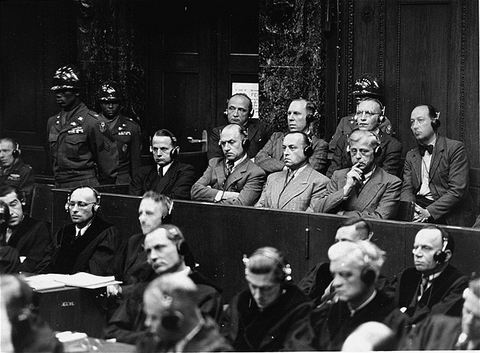 Some of the defendants in the dock during the trial of the Einsatzgruppen Source: U.S. Holocaust Memorial Museum.
Some of the defendants in the dock during the trial of the Einsatzgruppen Source: U.S. Holocaust Memorial Museum. Chief prosecutor Benjamin Ferencz Source: U.S. Holocaust Memorial Museum.
Chief prosecutor Benjamin Ferencz Source: U.S. Holocaust Memorial Museum.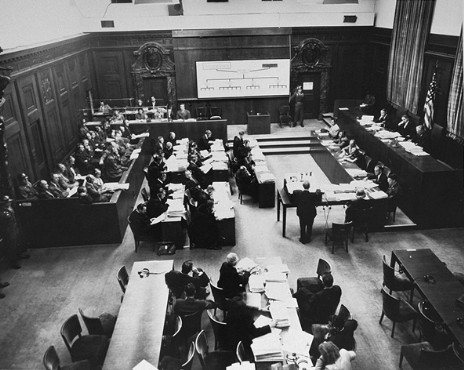 Overview of the court room Source: U.S. Holocaust Memorial Museum.
Overview of the court room Source: U.S. Holocaust Memorial Museum.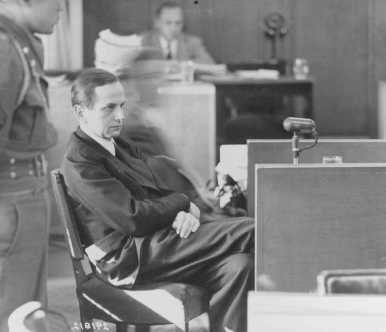 Major defendant Otto Ohlendorf makes a statement during the tribunal in Nurnberg, October 1947. Source: U.S. Holocaust Memorial Museum.
Major defendant Otto Ohlendorf makes a statement during the tribunal in Nurnberg, October 1947. Source: U.S. Holocaust Memorial Museum. Film fragment of the opening statement of Benjamin Berell Ferencz during the Einsatzgruppen-trial. Source: Robert H. Jackson Centre.
Film fragment of the opening statement of Benjamin Berell Ferencz during the Einsatzgruppen-trial. Source: Robert H. Jackson Centre.Memories
In comparison to the extermination of the Jews in the gas chambers the genocide of the Jews in the Soviet-Union by the Einsatzgruppen and their collaborators has never received much attention from the general public. Extermination camp Auschwitz has become the symbol of the Holocaust and the names of murder sites such as Rumbula, Kaments-Podolski, Babi Jar and Bikernieki are relatively unknown to the general public. One explanation is that the victims of the Einsatzgruppen were Soviet Jews and not West European Jews like in Auschwitz. The victims are anonymous to the western public, their history and culture unfamiliar. Secondly the mass executions took place far outside the western sphere of influence, hidden behind the Iron Curtain after the war. During the Cold War western historians were denied access to the Soviet archives and only after the break up of the Soviet-Union in 1991 they were able to start local research. Earlier research by the Soviet authorities was diffused by political opportunism. At mass graves pompous memorials were erected memorizing the Soviet civilians who fell victim to fascism but Jews remained anonymous.
After the Iron Curtain had come down and former Soviet-states were changing into young democracies, the fate of the Jews was brought into the open in more and more locations. In 1991 at Babi Jar, with permission of the Ukrainian authorities, a monument was erected in memory of the Jewish victims of the mass murder which took place there fifty years before. The earlier monument which had stood there since 1976, only memorized Soviet citizens in general and prisoners of war who had fallen victim to the Nazi-occupation. In the Baltic states it took until the 21st century before the fate of the Jews was officially recognized. In nationalist circles the German invasion was and still is often recognized as a liberation from Soviet occupation. The far reaching collaboration with the Germans by fellow countrymen and the participation in the genocide of the Jews remain sensitive issues. In Latvia for example it took until 2002 before a monument was erected at the execution site in the forest of Rumbula for the 25,000 Jews who were killed here during the Second World War by the Nazis and the Latvian militia. The Latvian president Vaira Vike-Freiberga delivered a speech at the unveiling ceremony and she called it "a day of mourning for everybody in Latvia as this crime took place on our territory and because our people participated in it".
Many execution sites in the former Soviet-Union have faded into oblivion. The French priest Patrick Dubois took this to his heart and in 2004 he started searching for mass graves in the Ukraine and documenting statements of local people who had witnessed the mass murders. In 2010 he had already spoken to 950 eyewitnesses and localized 700 mass graves. His research is far from completed, as he wants to continue his mission in Byelorussia and other parts of the former Soviet-Union when he is finished in the Ukraine. All this in the first place to do justice to the victims by drawing attention to their forgotten fate but his objective is even more ambitious. He writes about it in his book Holocaust by bullets: "My work is an act of justice towards the dead in the first place and of rebuilding society but also an act to prevent other genocides. My work is intended to convey a message to every culprit to the effect that, sooner or later, somebody will shed light on his crime."
Definitielijst
- collaboration
- Cooperation of the people with the occupying forces, more generally spoken the term for individuals who cooperate with the occupying force is collaborator.
- Einsatzgruppen
- "Taskforces of Deployment Squads". Special units composed of various SS and police services under supervision of the Reichssicherheitshauptamt (RSHA). Einsatzgruppen were deployed during the invasion of Poland in 1939 and during operation Barbarossa in 1941. In 1939 these units were ordered to eliminate the Polish intelligentsia. In the Soviet Union they were deployed to execute various political and racial enemies of the Third Reich, like Jews, gypsies and communists. The "Holocaust by bullets" in the Soviet Union was the horrendous first act of the eventual "final solution".
- fascism
- Original name of the antidemocratic political movement in Italy under command of dictator “Il Duce” Benito Mussolini. Mussolini was the leader of Italy from 1922 to 1943. Nowadays the term fascism is a much used term for antidemocratic political movements. Sometimes German national socialism is called fascism.
- Holocaust
- Term for the destruction of European Jewry by the Nazis. Holokauston is the Greek term for a completely burnt sacrifice.
- invasion
- Armed incursion.
- Jews
- Middle Eastern people with own religion that lived in Palestine. They distinguished themselves by their strong monotheism and the strict observance of the Law and tradition. During World War 2 the Jewish people were ruthlessly persecuted and annihilated by the German Nazis. . An estimated 6,000,000 Jews were exterminated.
- Nazi
- Abbreviation of a national socialist.
Images
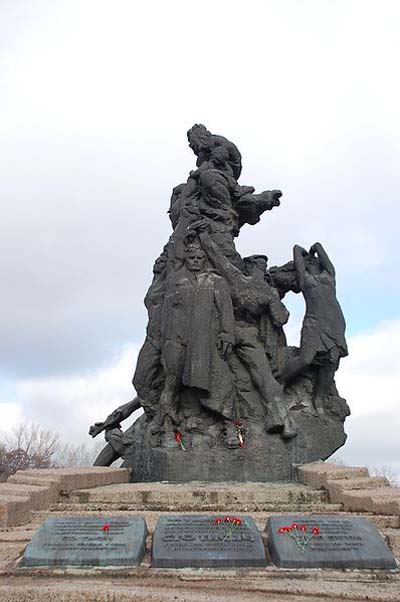 The pompous Soviet memorial which was erected near Babi Jar in 1976. Source: Roland Geider.
The pompous Soviet memorial which was erected near Babi Jar in 1976. Source: Roland Geider.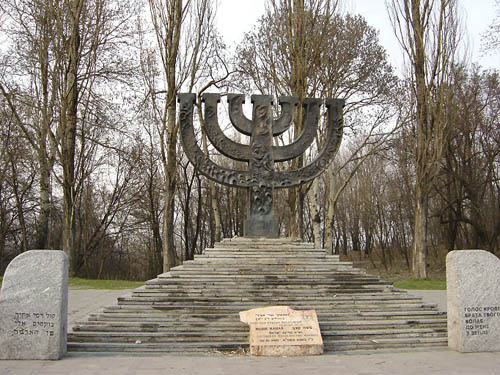 The monument for the Jewish victims erected in 1991 near Babi Jar Source: Mark Voorendt.
The monument for the Jewish victims erected in 1991 near Babi Jar Source: Mark Voorendt.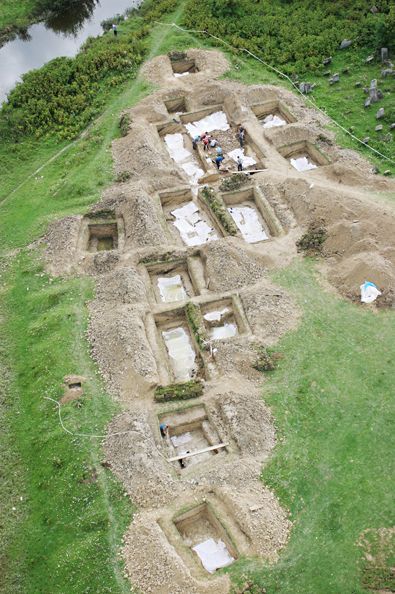 A mass grave which is being researched by the priest Desbois and his team. Source: Holocaust door kogels.
A mass grave which is being researched by the priest Desbois and his team. Source: Holocaust door kogels.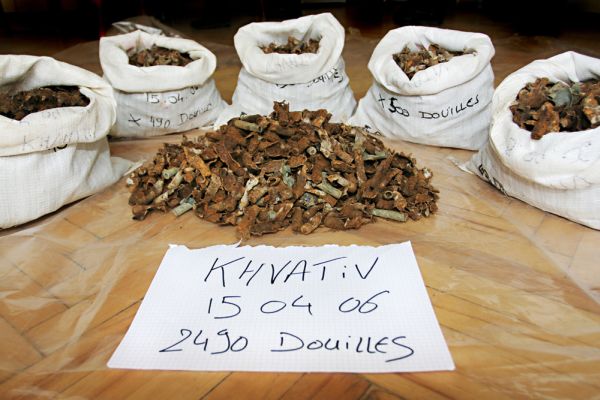 Bullets near a mass grave dug up by the research team of priest Dubois. Source: Holocaust door kogels.
Bullets near a mass grave dug up by the research team of priest Dubois. Source: Holocaust door kogels.Information
- Article by:
- Kevin Prenger
- Translated by:
- Arnold Palthe
- Published on:
- 12-02-2016
- Last edit on:
- 24-05-2023
- Feedback?
- Send it!
Related sights
Related books
Sources
- ARAD, Y., Belzec, Sobibor, Treblinka, Indiana University Press, Bloomington (USA), 1999.
- BENNETT, G.H., The Nazi, the Painter and the Forgotten Story of the SS Road, Reaktion Books, Londen, 2012.
- BREITMAN, R., Hitler's Shadow, CreateSpace, 2011.
- BROWNING, C.R., Ordinary Men, Penguin Books, Londen, 1998.
- DAWSON, G., Judgment before Nuremberg, Pegasus Books, New York, 2012.
- DESBOIS, P., Holocaust door kogels, Verbum, Laren, 2009.
- EARL, H., The Nuremberg SS-Einsatzgruppen Trial 1945-1958, Cambridge University Press, New York, 2009.
- EVANS, R.J., Het Derde Rijk deel 3, Spectrum, Houten, 2009.
- GOLBERT, M., The Routledge Atlas of the Holocaust, Routledge, Londen, 2002.
- HILBERG, H., De vernietiging van de Europese Joden, Verbum, Laren, 2008.
- KLEE, E., Das Personenlexikon zum Dritten Reich, Fischer, Frankfurt am Main, 2007.
- KLEE, E. e.a., The Good old Days, Konecky & Konecky, New York, 1988.
- KNOPP, G., Hitlers troepen, Standaard Uitgeverij, Antwerpen, 2008.
- MACLEAN, F., The Field Men, Shiffer Military History, Atglen (USA), 1999.
- POHL, D., Holocaust, Verbum, Laren, 2005.
- RHODES, R., Masters of Death, Vintage Books, New York, 2002.
- SNYDER, T., Bloedlanden, Ambo, Amsterdam, 2011.
- SPECTOR, S. & ROZETT, R., Encyclopedie van de Holocaust, Kok, Kampen, 2004.
- WILDT, M., Generation des Unbedingten, Hamburger HIS, Hamburg, 2003.
- Prenger, K., "De vergeten Holocaust, priester Desbois en zijn missie", Wereld in Oorlog, nr. 14, oktober 2010.
- BBC News, "Latvia unveils Holocaust memorial", 29-11-2002.
- www.axishistory.com
- www.benferencz.org
- www.holocaust-history.org/german-trials
- www.ushmm.org
- www1.yadvashem.org
